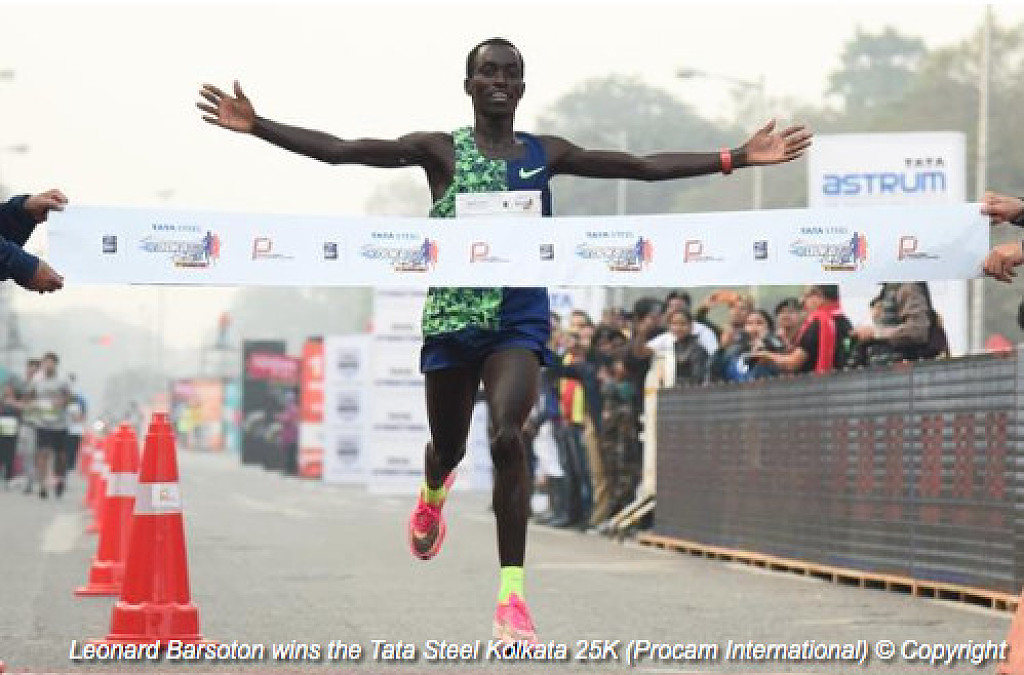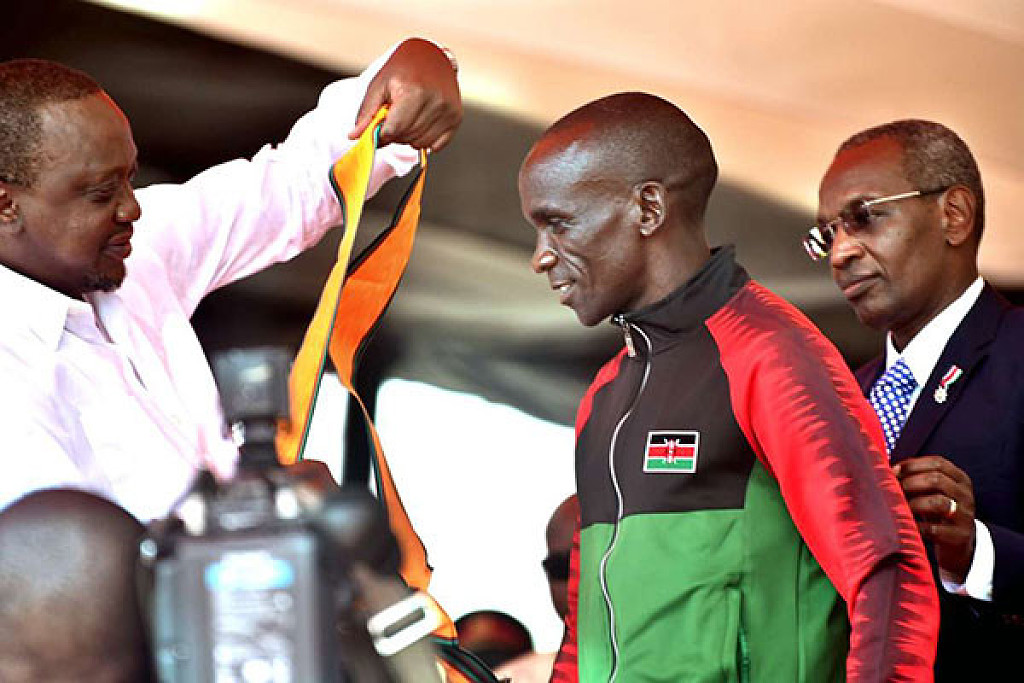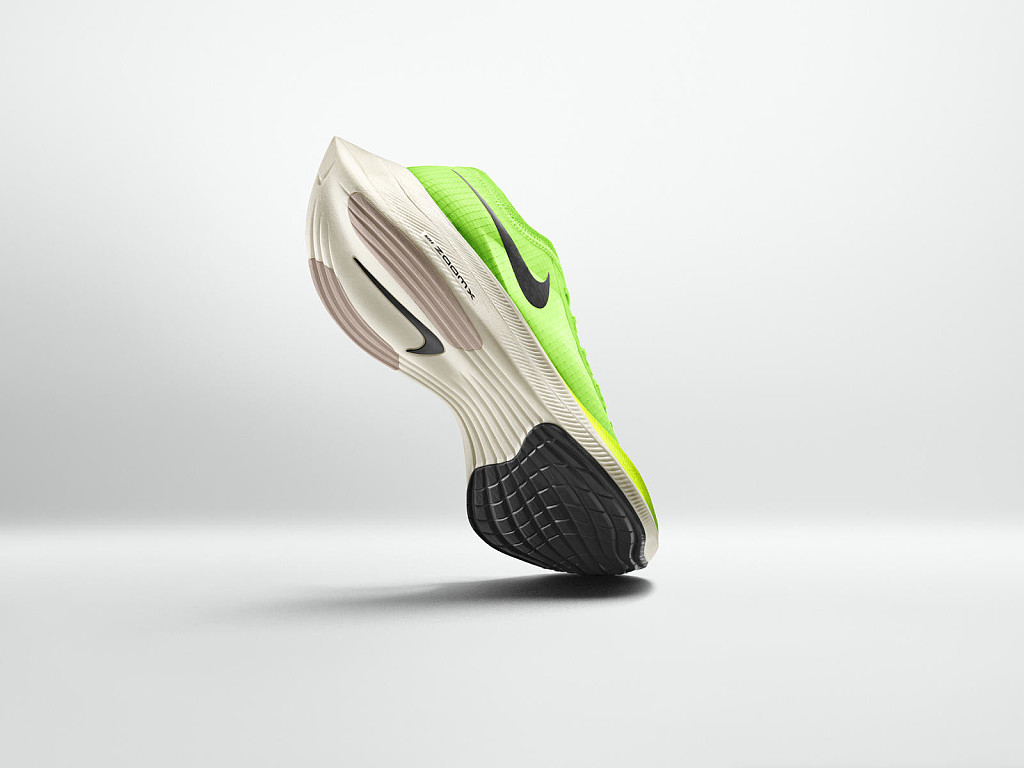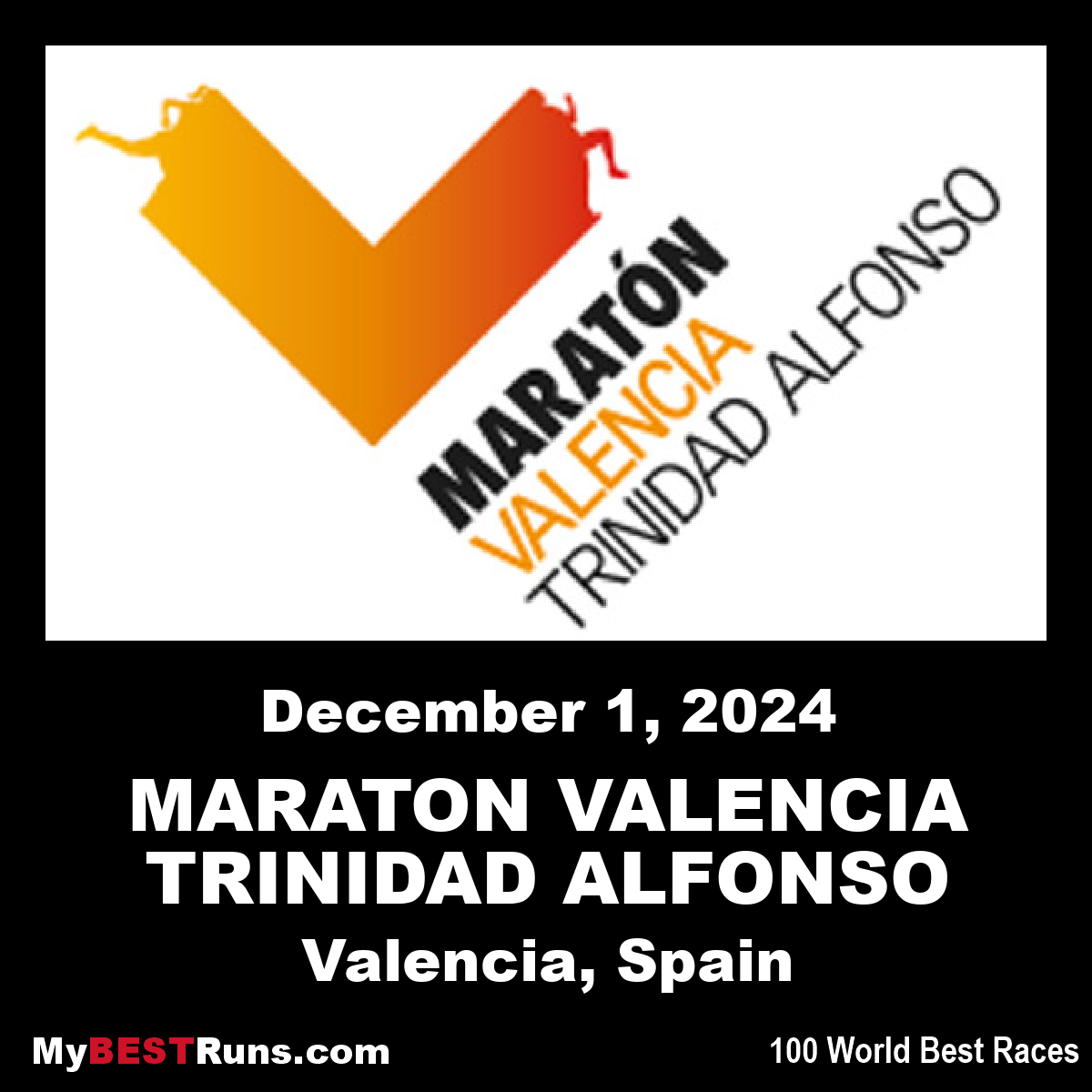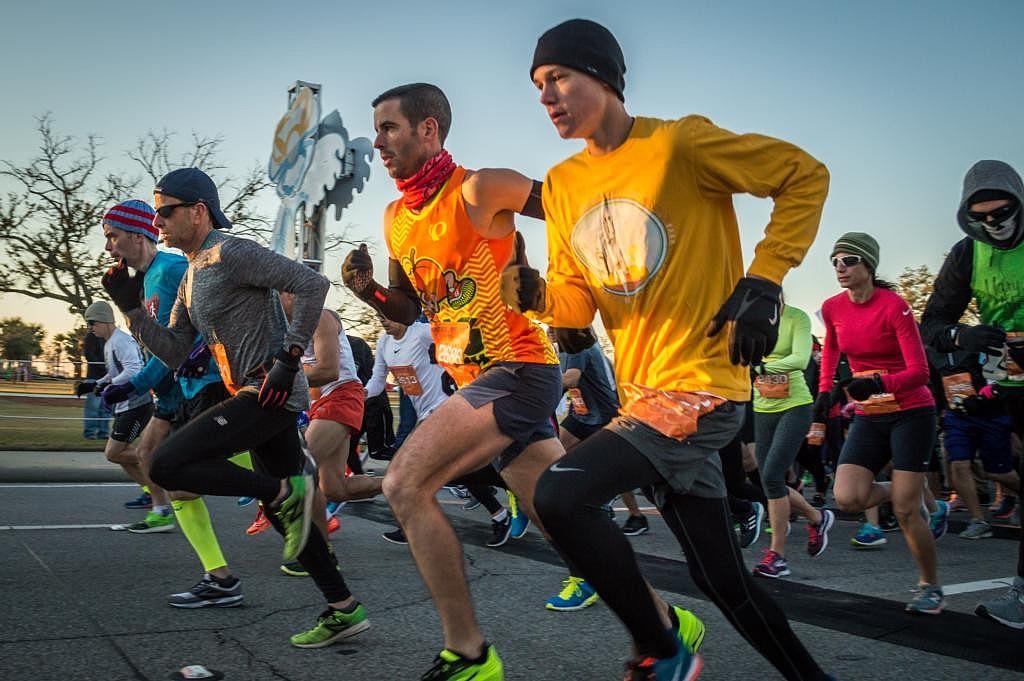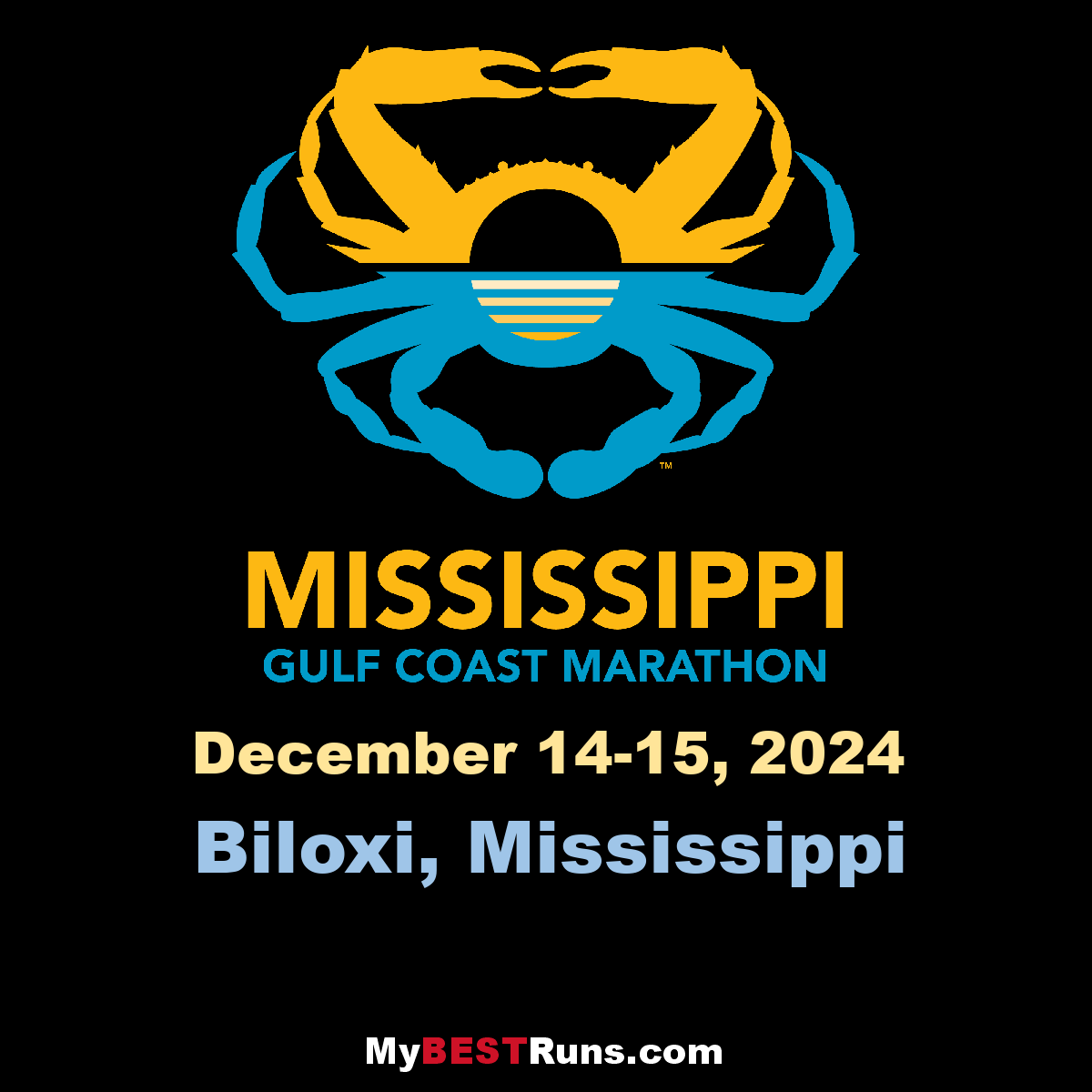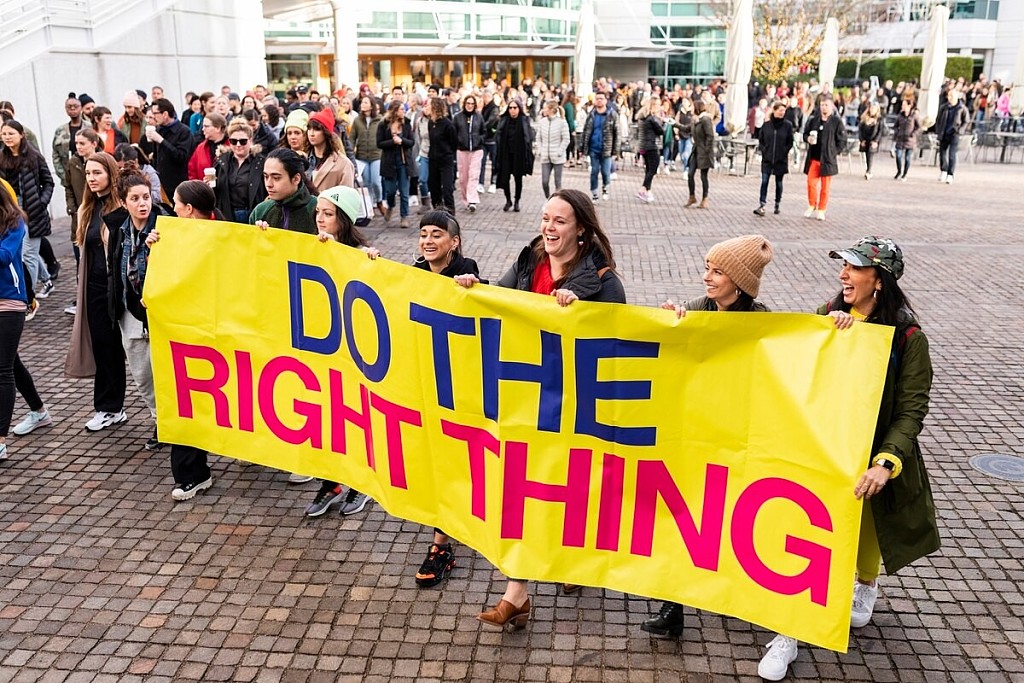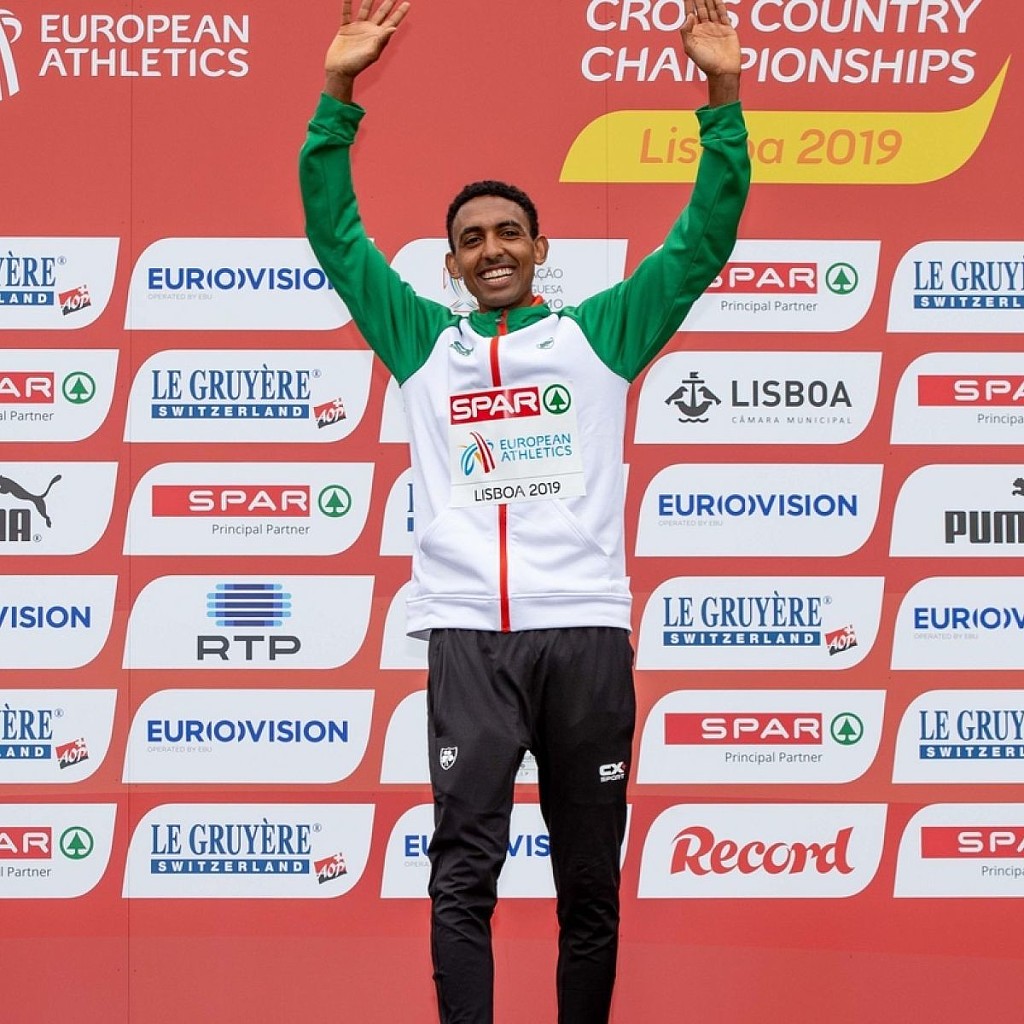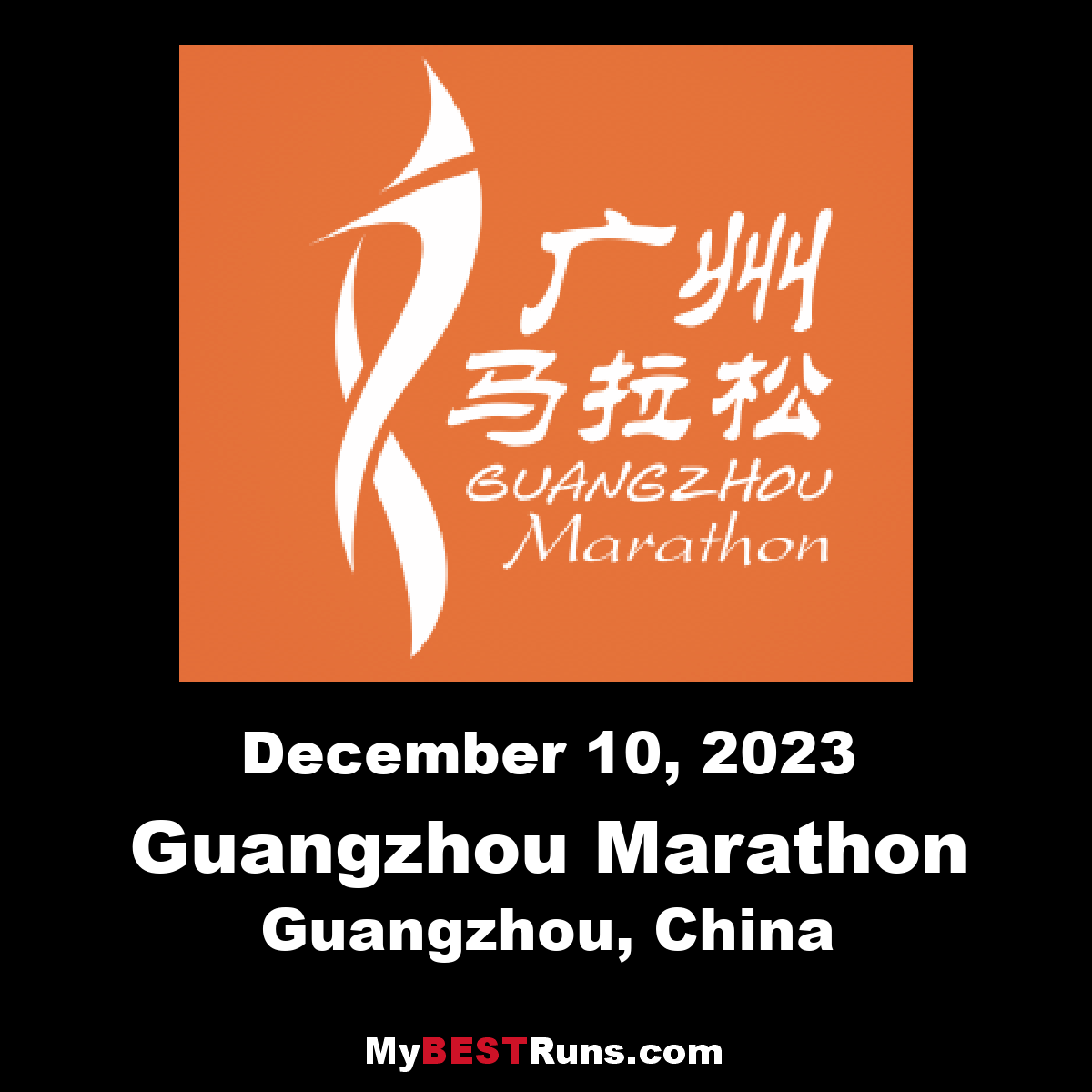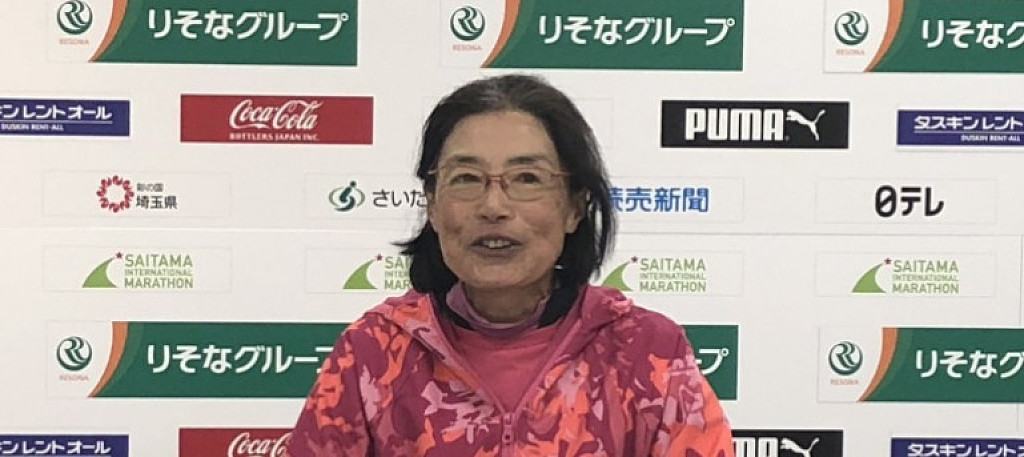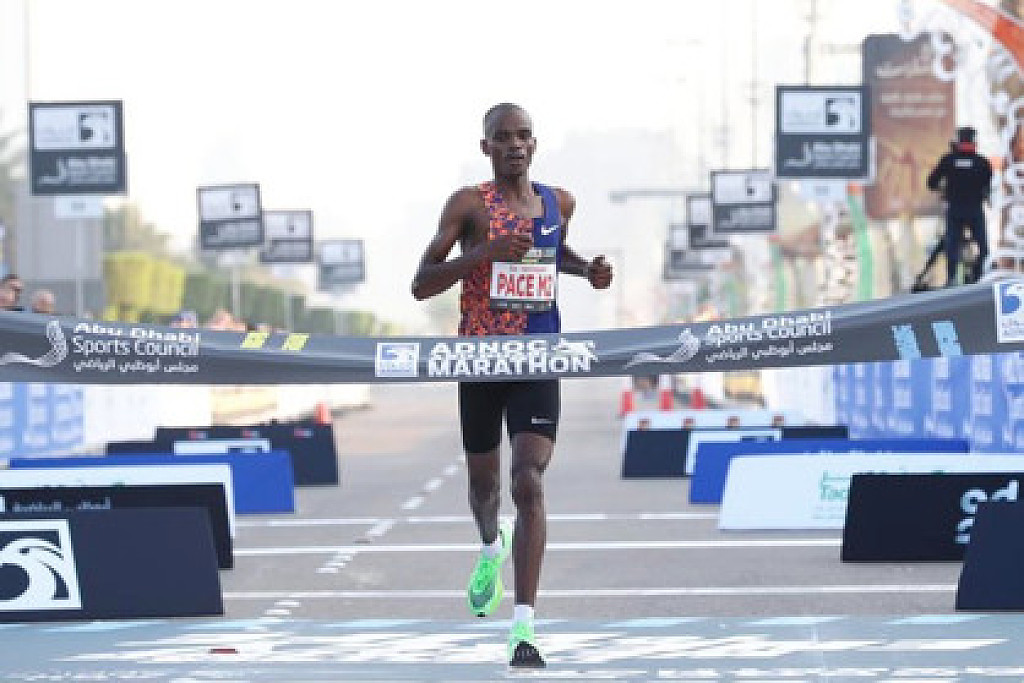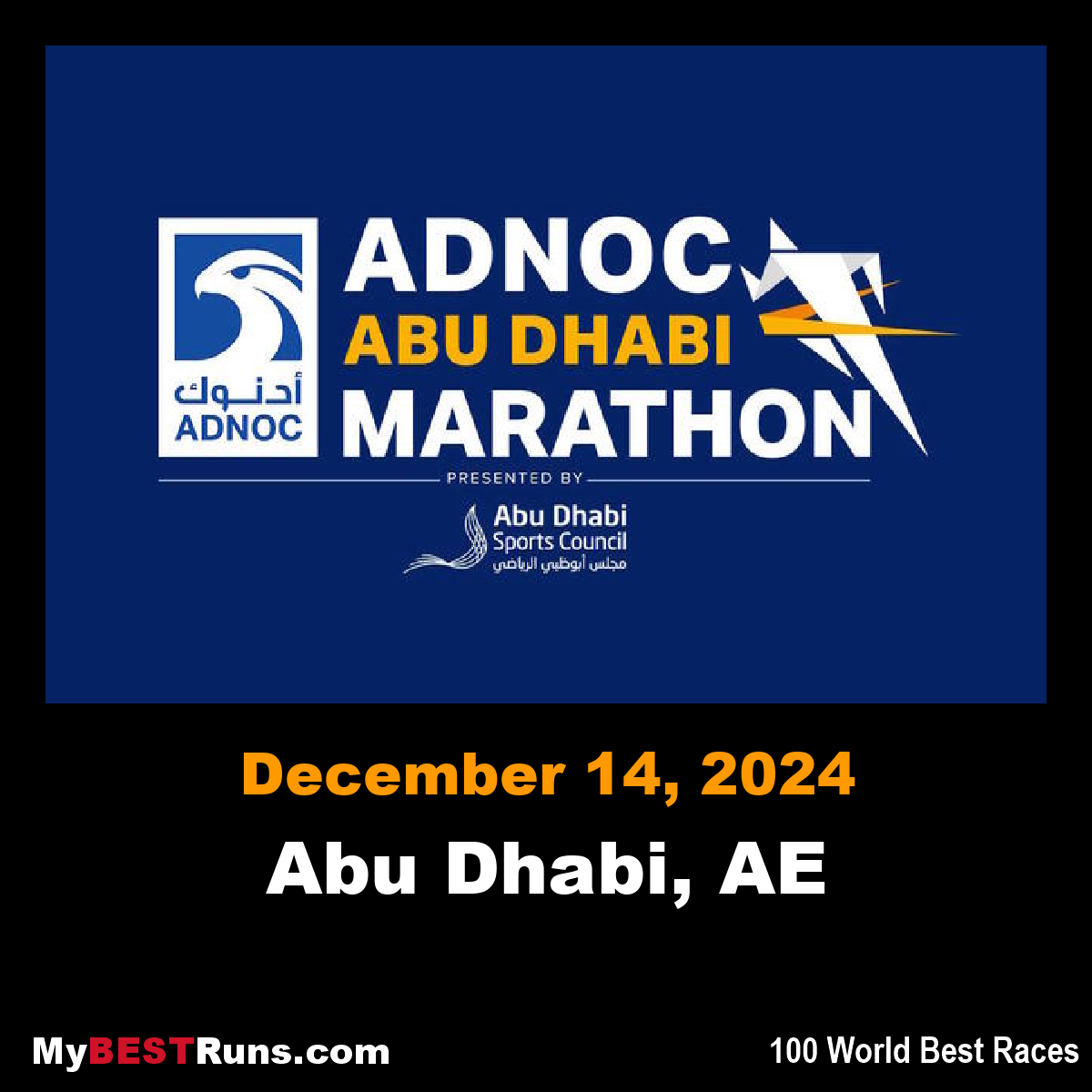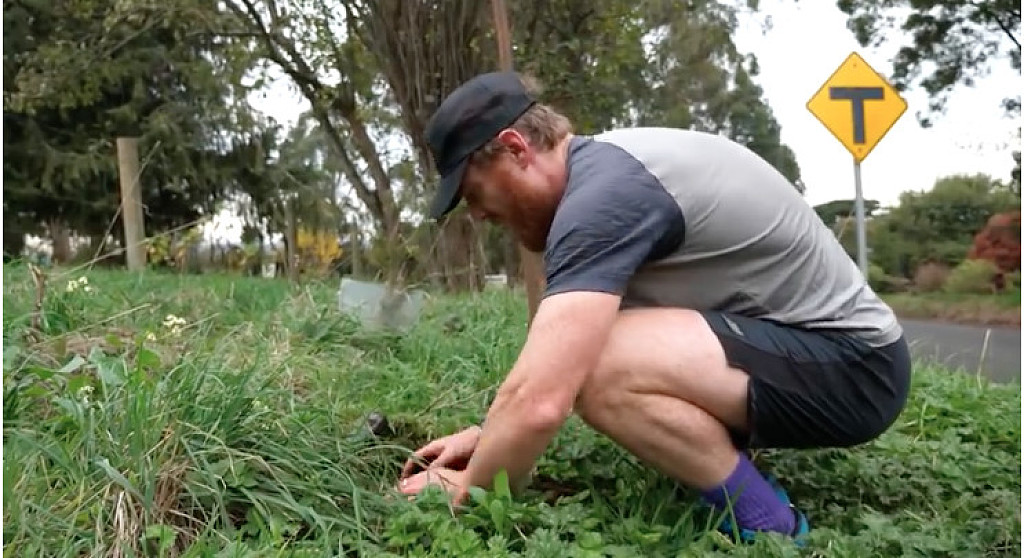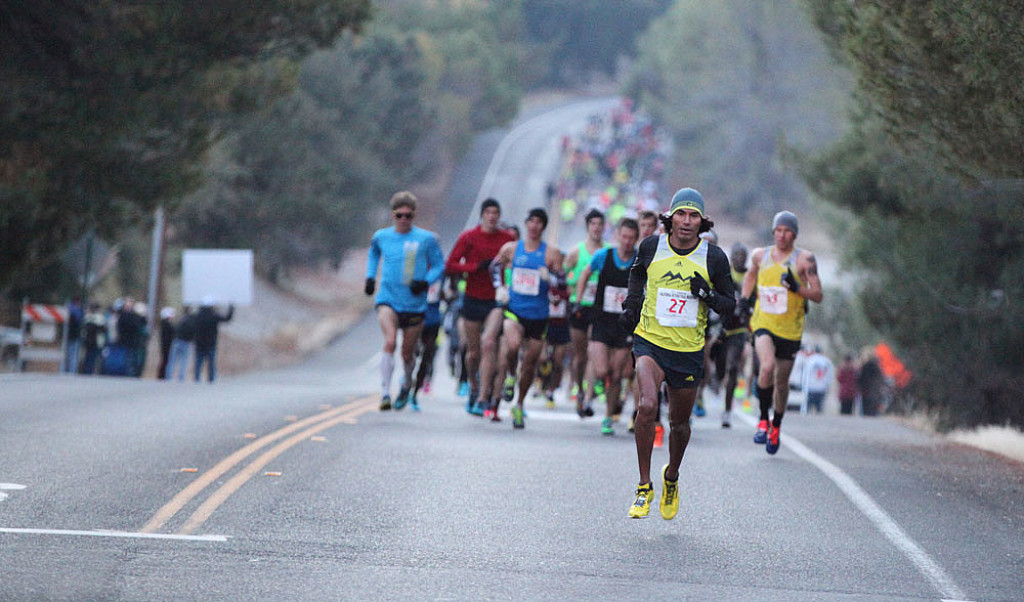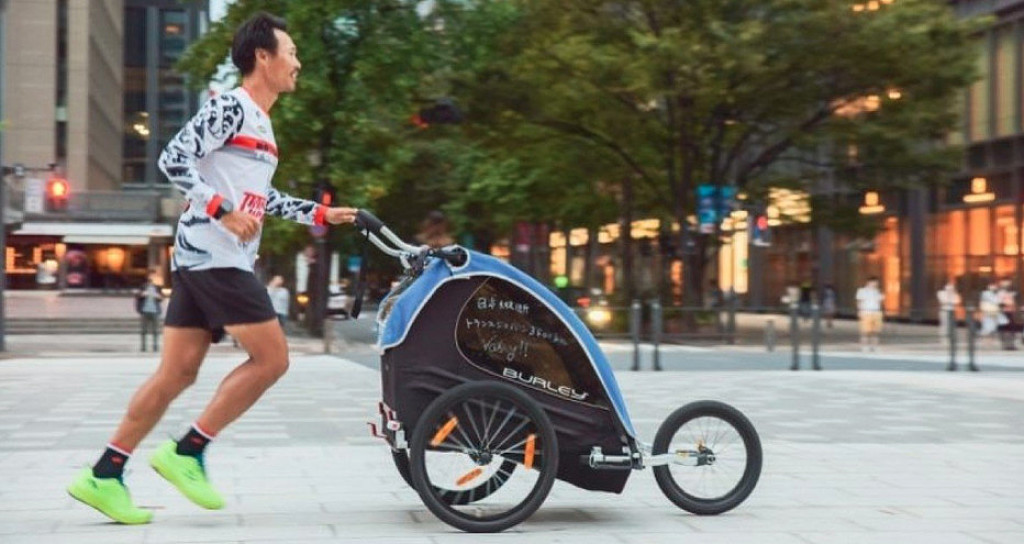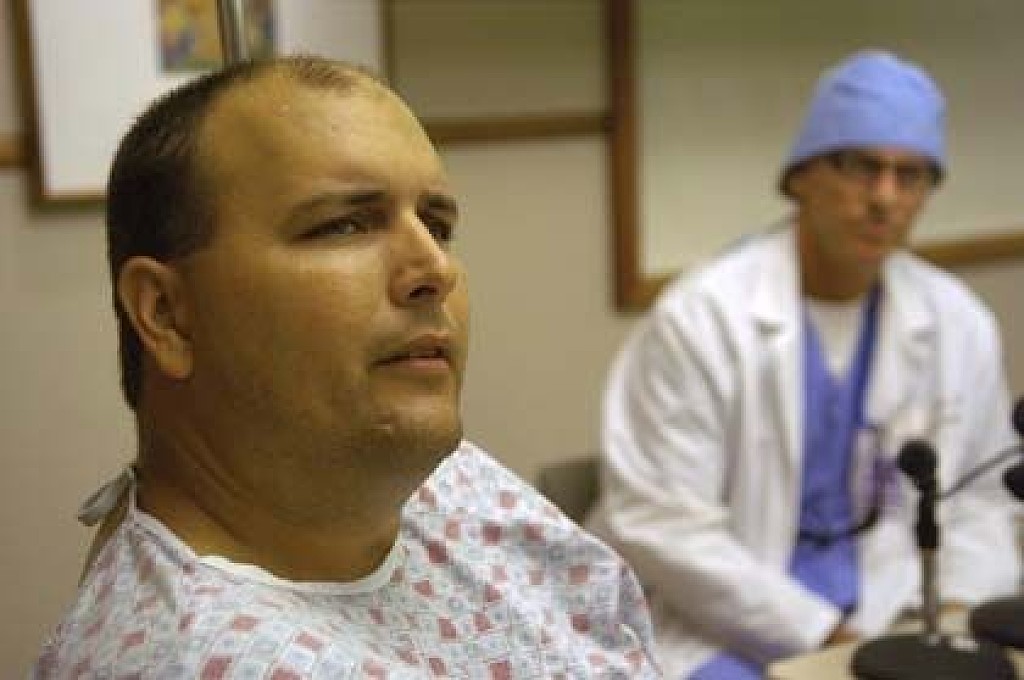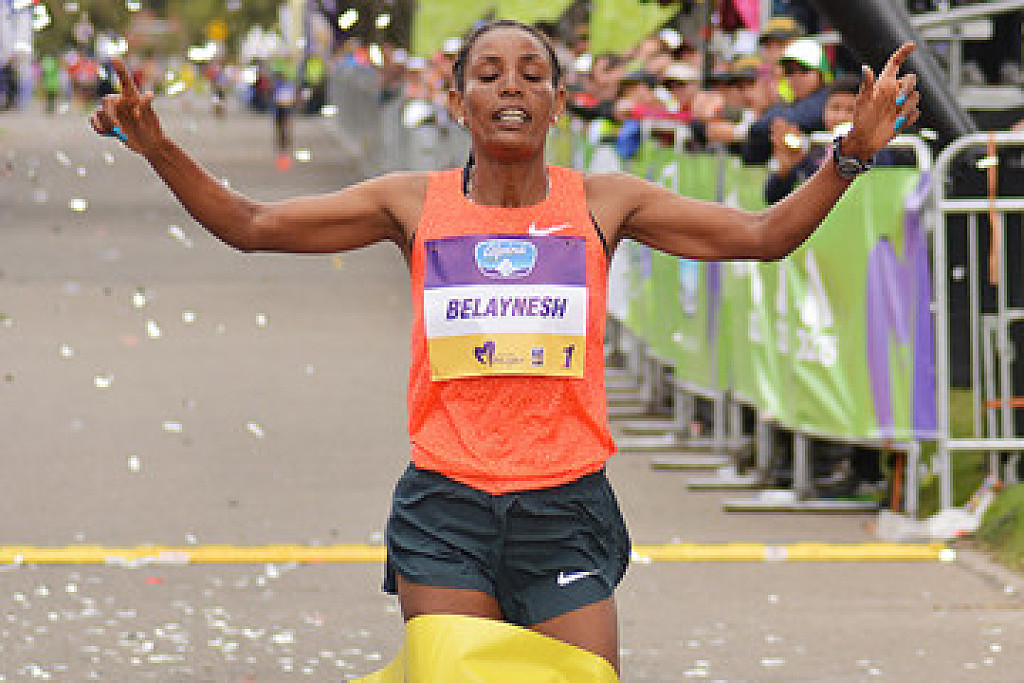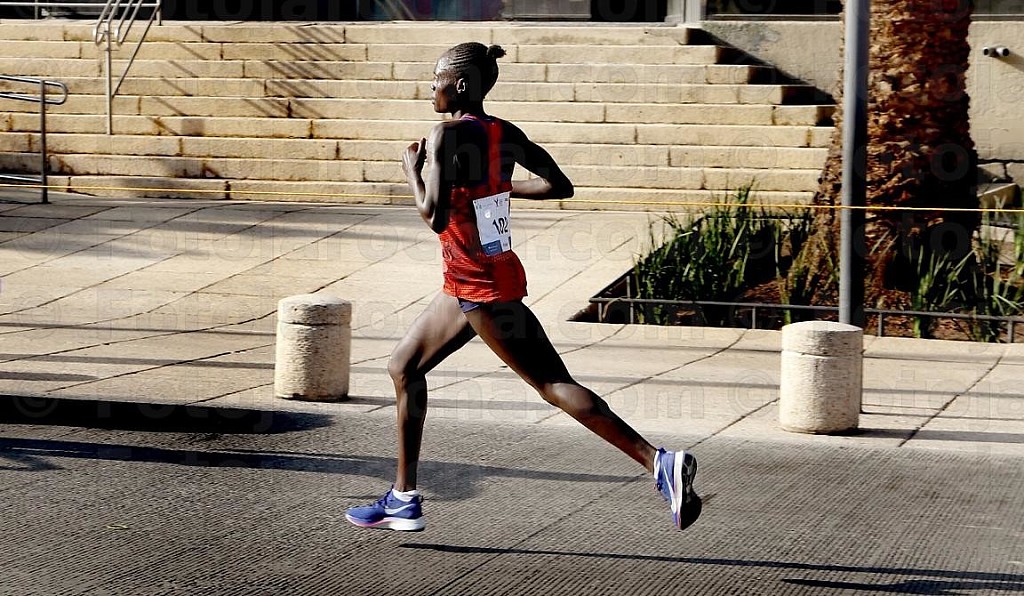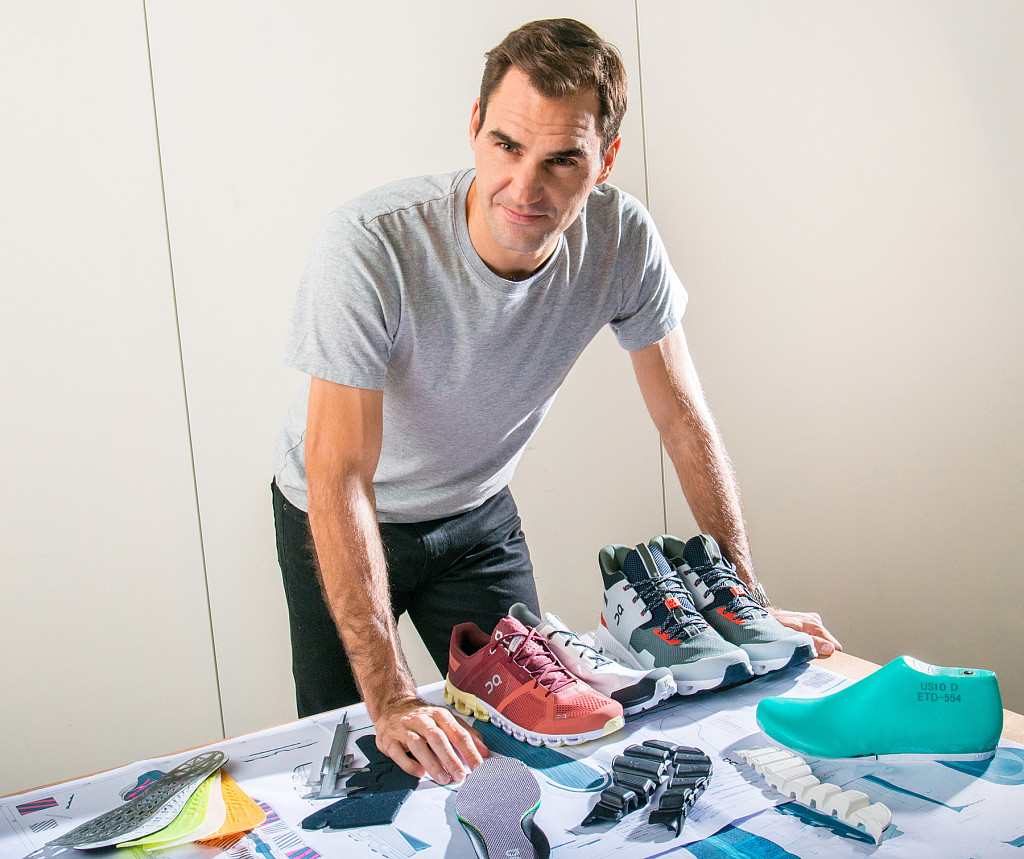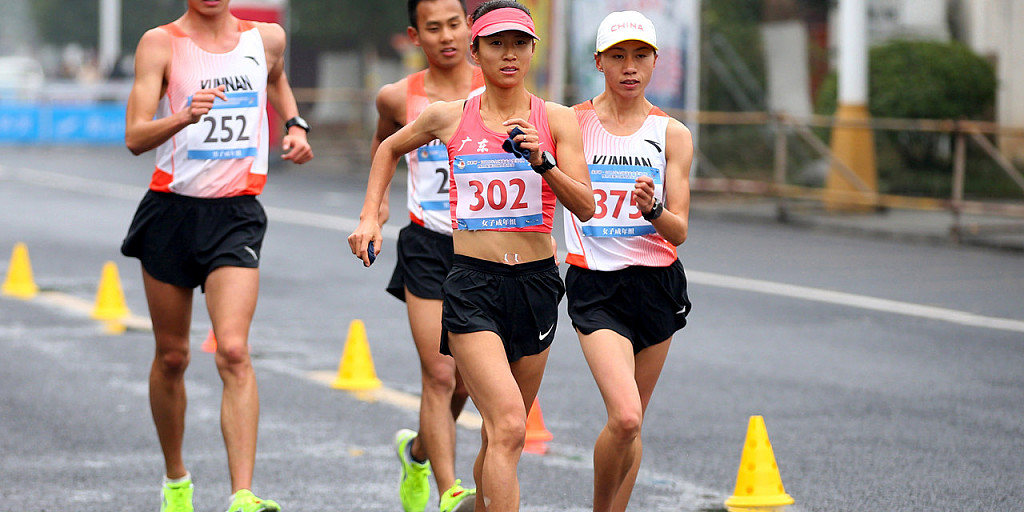Running News Daily
Running News Daily is edited by Bob Anderson in Los Altos California USA and team in Thika Kenya, La Piedad Mexico, Bend Oregon, Chandler Arizona and Monforte da Beira Portugal. Send your news items to bob@mybestruns.com Advertising opportunities available. Train the Kenyan Way at KATA Kenya. (Kenyan Athletics Training Academy) in Thika Kenya. KATA Portugal at Anderson Manor Retreat in central portugal. Learn more about Bob Anderson, MBR publisher and KATA director/owner, take a look at A Long Run the movie covering Bob's 50 race challenge.
Index to Daily Posts · Sign Up For Updates · Run The World Feed
15 Mind-Blowing Race Moments From 2019-From Kipchoge to Kosgei and all of the upsets, records, and victories in between, 2019 was a major year for running.
1-Kosgei Shocks Everyone in Chicago-On October 13, Brigid Kosgei made history when she won the Chicago Marathon in 2:14:04. The Kenyan ran almost perfectly even splits to achieve her goal in the Windy City, passing the halfway mark in 1:06:59 before clocking 1:07:05 for the second half.
2-Eliud Kipchoge Dips Under 2-Hour Marathon Barrier-In his second attempt at breaking the two-hour barrier in the marathon, Eliud Kipchogeof Kenya accomplished the feat with a stunning run of 1:59:40 on the streets of Vienna in October.

3-Joan Samuelson Crushes Her Goal 40 Years After Boston Victory-In 1979, Joan Benoit Samuelson set a national and course record when she won the Boston Marathon as a 21-year-old college student. Forty years after her historic victory, Samuelson, 61, set out to run within 40 minutes of her winning time at the 2019 Boston Marathon. On April 15, the 1984 Olympic champion wore a similar Bowdoin College singlet to honor her 1979 win and shattered her goal, crossing the finish line in 3:04. “To be here, 40 years later and being able to run, let alone being able to run a marathon, I feel blessed,” she said.
4-Jim Walmsley Obliterates His Own Western States Record-Ultrarunning star Jim Walmsley maintained his Western States winning streak when he obliterated his own course record in June. Navigating 100 miles from Squaw Valley to Auburn, California, Walmsley broke the tape in 14 hours and 9 minutes, which broke his own course record by more than 20 minutes
5-Donavan Brazier Breaks 34-Year-Old American Record-Donavan Brazier had the race of his life when he broke one of the oldest American records on his way to winning gold in the 800 meters at the IAAF World Championshipsin Doha, Qatar. With 250-meters to go, Brazier ran away from the field to secure the first 800-meter world championship gold medal for the United States in a time of 1:42.34.
6-Dalilah Muhammad Sets World Record Twice-Dalilah Muhammad made history twice this season when she broke the 400-meter hurdles world record and lowered it once again on her way to winning the world championships.

7-Sifan Hassan Wins Unprecedented Double at Worlds-At the IAAF World Championships in Doha, Sifan Hassan won two gold medals that no man or woman has achieved in the history of the world championships or Olympic Games. The Dutch runner, 26, kicked off the competition by winning the 10,000-meter final in a national record time of 30:17:33.
8-Maggie Guterl Becomes First Woman to Win Backyard Ultra-For 60 hours straight, Maggie Guterl ran the same 4.2-mile trail loop to become the last runner standing in the Big’s Backyard Ultra race. The Durango, Colorado, native ran 250 miles on her way to becoming the first woman to win the brutal race that rewards the person who can run for the longest amount of time.
9-Geoffrey Kamworor Breaks Half Marathon World Record-Holding a 4:25-mile pace, Geoffrey Kamworor of Kenya shattered the world record at the Copenhagen Half Marathon in September, running 58:01. The performance, which was 17 seconds faster than the previous record, took place in the same city where the 26-year-old won his first of three half marathon world championship titles in 2014.
10-Joyciline Jepkosgei Debuts in NYC Marathon, Beats Mary Keitany-In her first marathon, Joyciline Jepkosgei of Kenya secured a title in a major upset. The half marathon world record-holder raced like a veteran in the New York City Marathonto beat four-time champion Mary Keitany in a winning time of 2:22:38, only seven seconds shy of the course record.
11-Kenenisa Bekele Wins Berlin Marathon 2 Seconds Shy of World Record-One year after Eliud Kipchoge set a world record that many believed would be untouchable for at least a few years, Kenenisa Bekele nearly surpassed it at the Berlin Marathon. The 37-year-old Ethiopian won the race in 2:01:41, just two seconds shy of Kipchoge’s record.
12-Freshman Sha’Carri Richardson Shatters 100-meter Collegiate Record-In her first ever NCAA Outdoor Championship, Sha’Carri Richardson made history. In the 100-meter final, the LSU freshman sprinted to victory in a collegiate record of 10.75.
13-Drew Hunter, Athing Mu, and Colleen Quigley Win First Pro Titles-The USATF Indoor Championships brought out exciting breakthroughs for three young athletes. In the men’s 2-mile, 21-year-old Drew Hunter won the crown out of the “slower” heat by running a world-best time of 8:25.29. The women’s 600 meters was won by 16-year-old Athing Mu who defeated world silver medalist Raevyn Rogers in an American record time of 1:23.57.
14-BYU Snaps NAU’s Winning Streak at the NCAA Cross Country Championships-The Brigham Young team had a banner day at the NCAA Cross Country Championshipsin November. Battling muddy conditions, the BYU Cougars secured the team victory over three-time defending champions Northern Arizona in the men’s race. With a team total of 109 points, BYU beat NAU by 54 points to win the program’s first NCAA cross-country championship in history.
15-Joshua Cheptegei Sets 10K World Record After Winning Two World Titles-Joshua Cheptegei of Uganda capped off a banner year when he set a world record in the 10K on December 1, running 26:38 to win the 10K Valencia Trinidad Alfonso in Valencia, Spain. Earlier this year, he won the world cross-country championships and the world championship 10,000 meters in Doha, Qatar.
(12/15/2019) ⚡AMP
by Runner’s World
Barsoton and Shone smash race records at Kolkata 25K
Kenya’s Leonard Barsoton and Ethiopia’s Guteni Shone ripped up the record book at the Tata Steel Kolkata 25K 2019 as the pair set new event records for the World Athletics Silver Label Road Race – the only 25km race in the world with such a distinction – on Sunday (15).
Barsoton, the 2017 World Cross Country Championships silver medallist, crossed the line in 1:13.:05 to take 43 seconds off the event record set by Ethiopia’s Kenenisa Bekele in 2017 while Shone clocked 1:22:09 to win by more than a minute. She clipped took almost four minutes off the event record of 1:26:01 set by her compatriot Degitu Azimeraw two years ago.

Both of the winning times rank just outside the top 10 all-time marks for the 25km distance.
A large group of 11 runners in the men’s race went through the halfway point at 12.5km together in 37:11 (the 10km split being 29:41). However, over the next 2.5 kilometres several runners dropped off the back of the pack and just six were left at the front as 15km was passed in 44:21.
Despite the Ethiopian pair of Betesfa Getahun and Bayelign Yegsaw surging and pushing hard over the next five kilometres the same six – Barsoton, Getahun, Yegsaw, Uganda’s Felix Chemonges, Ethiopia’s Dagnachew Adere and Tanzania’s Faraja Damasi – were still more-or-less together as 20km was passed in 59:05; but with four kilometres to go Barsoton pushed hard for home and the move proved to be decisive.
Barsoton threw in a final 5km split of 14:00, the fastest 5km of the race, to win in 1:13:05 with Getahun, still with plenty of running in his legs despite his 2:05:28 marathon debut in Amsterdam less than two months ago, second in 1:33:33 and Yegsaw third in 1:33:36.
“It was a tough race and a tough course, and it was a close competition until the 20K mark, after which I broke free from the pack. I have been training hard this year, leading a disciplined life: sleeping early, rising early and training hard,” reflected Barsoton, whose previous credentials also include a half marathon personal best of 59:09 in Valencia in October.
"I had planned to push hard from 20km but looking at the other runners I decided to wait a little bit and then went at 21-k. But to beat a record of Bekele’s is so special. I’m very excited.
“Next year, for sure I will make my marathon debut, but I don’t know where yet. However, I think I can run 2:03, a crazy time. If I can beat Bekele’s record here, I can run that sort of crazy time,” added Barsoton.
Bekele’s brother Tariku Bekele drifted off the back of the leading pack just after 13 kilometres and eventually finished 10th in 1:15:53 while Kenya’s 2009 and 2011 world marathon champion Abel Kirui, a late addition to the race, was a distant 11th in 1:18.08.
In contrast to the way the men’s race unfolded, Shone was out on her own over the last 10 kilometres.
After a group of seven women had passed 10km in 33:37, Shone started to increase the tempo and by the halfway point just had her training partner Desi Jisa for company.
The Ethiopian-born Bahraini hung on doggedly for another couple of kilometres but by 15km, which Shone passed in 50:03, the 2019 Sevilla Marathon winner was starting to pull away from her rival.
Shone passed 20km in 1:06:00 with Jisa now 42 seconds back and the gap continued to grow over the final five kilometres, which was covered in 16:09, before Shone crossed the line in 1:22:09.
Jisa hung on to take second in 1:23:32 with another Ethiopian-born Bahraini, Tejitu Daba, exactly one minute further back in third. The first five finishers were inside the former women’s event record.
“I have practiced (trained) very hard throughout the year and it is yielding results now,” Shone said.
“The temperature was a little hot and since the running was through the city there were many turns and bents to make the race tough. Moreover, you did not know what kind of surface to expect next, so you had to keep guessing. All of that made the course challenging and worth the run,” she added.
(12/15/2019) ⚡AMP
by World Athletics
Diane Leather and Roger Bannister – the similarities and differences of two trailblazers
The world reverberated with the news that Roger Bannister had become the first man to run the mile in less than four minutes on 6 May 1954. Twenty three days later, a landmark was achieved in the women’s mile when fellow Briton Diane Leather became the first to dip under five minutes – unheralded, and, at the time, without fanfare.
Bannister’s progress continued to top the sporting agenda as he beat his Australian rival, and by then world mile record-holder, John Landy at the British Empire and Commonwealth Games in Vancouver, before hoovering up the European 1500m title and retiring to start a stellar career in medical research.

Leather remained as a runner until 1961, but while she won two silver medals in the 800m at the European Championships, and captained the women’s team at the 1960 Rome Olympics, she never got the chance to run at her best distance in a major international championship.
Less than a month after Bannister had clocked 3:59.4 at the Iffley Road track in Oxford, Leather recorded 4:59.6 at the Alexander Sports Ground in Birmingham – reacting with the words “Oh good. At last” – and the following year she ran 4:50.8 and then 4:45.0, which remained a world record until 1962.
By then Leather – who had also set an 800m world record of 2:09 in 1954 – had retired, aged 27. Women’s records for the mile were not ratified until 1967, and she never had the opportunity to race over her preferred distance at an international championship.

Both runners were honoured at the World Athletics Heritage Mile Night in Monaco last month with awards being made to Leather’s daughter, Lindsey Armstrong, and Bannister’s daughters Erin Bannister-Townsend and Charlotte Bannister-Parker.
The contrast in recognition for two great athletes who both died in 2018 was mirrored, oddly, in a contrast in recognition within their own families.
Lindsay Armstrong had no idea that her mum had been an athlete, or indeed a world record-holder, until she was 11.
“She didn’t tell me herself,” recalled Lindsay, who runs Shakespeare’s Schoolroom and Guildhall in Stratford-upon-Avon. “I learned about it when I found some scrapbooks that one of her brothers had kept. They were on the bottom shelves somewhere in the sitting room, just tucked away.
“I didn’t know what to do about it – it was almost as if I was being naughty!
“In the end it wasn’t really such a big conversation. She said it was just something she used to do.
“I don’t want you to get the wrong idea. She wasn’t shy and retiring. But it was just something she’d done.
“On the day she broke five minutes for the mile, she had broken an 800m record earlier that day – it may have been a national record. So she had two great legs on her.
“She ran in the Olympics in 1960, but again they still didn’t allow her to run the mile. There was nothing further than the 200 until 1960 and then they were allowed to do the 800m. So she was the women’s team captain but she didn’t get to the final. Because, you know, it was six years past her prime. We have still got her Olympic jacket at home. She stopped soon after that.
“She didn’t talk about her athletics. I know that in later years according to people that knew her then that she felt somewhat slighted, and instead of letting it upset her she just turned away from athletics earlier than she would have done.
“But she did a lot of officiating in athletics after her career. So she didn’t really turn away from the sport. She always loved it.
“She was an extraordinary athlete. She ran the 400m, she ran the relay, she was a cross country champion. She did a huge range of distances.
“She was a chemist and she went on to be a child social worker. That was her passion. She was more than just an athlete. She was an extraordinary woman who really did change lives.
“She was beautiful – so beautiful. You could see it in the film we just watched. And it was really lovely to see. We were so proud of her. To be here with all these other extraordinary runners – she would have loved to be here.”
By contrast, Bannister’s daughters Charlotte, who is a Church of England Minister at the University Church in Oxford, and Erin, an accomplished painter, recalled their father introducing athletics into their life from the point where they could remember.
“I think it would be fair to say that my father was a pretty humble man throughout his life considering what he achieved both medically and athletically,” said Charlotte.
“But in terms of us being aware that he was a runner and that running was important was something that happened right from the start of my very consciousness.
“We were encouraged to run every day. There was a little park outside our house which was a square, and he would run every day of his life, right until he had a car accident and he no longer could. But it was deeply engrained within our childhood. Much more… why it was good for you…
Her sister continued the narrative: “Why he loved to be outside… being outdoors, and including other sports, including climbing and walking, and tennis, and sailing, and a whole range of sports. He was always trying things that weren’t necessarily to do with athletics. So things like sailing were quite dangerous, but they gave us enormous fun.”
Charlotte recalled: “He would train us to get off the starting line. He just loved watching people run, and he would come to our school sports days and he would look around the field and he would say that young boy or that young girl, they have got great style.
“And then of course he was broadcasting at the Olympics as a journalist – that was one of the times we were allowed to watch television, to see the Olympic Games and the Commonwealth Games.
“He didn’t generally talk about his athletics, but during anniversaries of his achievements he would sometimes talk about them, and he would talk about how his father had taken him to see athletics very early on.
“I remember going to Crystal Palace with him a lot. And then of course when he was Chairman of the Sports Council he would have to attend a lot of sporting events and if my mother couldn’t make it he would take one of us children.
“And then of course there were interviews. When something happened in the athletics world, he used to get rung up by the BBC and asked to comment on things to do with drugs, apartheid, politics…”
Both recalled travelling to Vancouver in 1967 for the unveiling of a statue depicting the decisive moment of the Vancouver Mile race, when Landy looked back inside him as their father was making his decisive burst of speed in the lane outside.
Charlotte added: “We used to have very interesting Sunday lunches, where there were always discussions around politics, athletics and sport, and it would be a summary of the week’s news and what was going on in the wider world. So there was no sense of not being involved in what was his passion – or of him not passing on his passion to us.”
(12/15/2019) ⚡AMPby World Athletics
World marathon record holder Eliud Kipchoge has been awarded a Doctorate Degree of Law by the University of Exeter in the United Kingdom
According to the university, he was honored due to his commitment in the field of sports and being a marathon record holder.
The award comes days after Laikipia University also conferred Kipchoge a Doctorate Degree in Science during its seventh graduation ceremony.

An honorary degree is an academic degree for which a university has waived the usual requirements such as enrollment, a dissertation and the passing of comprehensive examination.

It is also known by the Latin phrases honoris causa ("for the sake of the honor") or ad honorem ("to the honor").
The degree is typically a doctorate or less commonly, a master’s degree, and may be awarded to someone who has no prior connection with the academic institution or no previous post-secondary education.
The degree is often conferred as a way of honoring a distinguished person's contributions to a specific field or to society in general.
(12/14/2019) ⚡AMPFormer Tokyo Marathon winner Sarah Chepchirchir, has been officially banned because of abnormalities in her athlete biological passport, which is usually evidence of abusing erythropoietin
Sarah Chepchirchir has previously been a training partner of 2016 Olympic Games marathon Jemima Sumgong, her sister-in-law, who is currently serving an eight-year drugs ban, under Italian coach Federicco Rosa.
The 35-year-old's ban has been backdated until April 11 last year and all her results from that period have been wiped from the record books.
Chepchirchir's most notable performance came in 2017, winning the Tokyo Marathon in a personal best 2 hours 19min 47sec.

She had also set a course record at the Paris 20K in 2013, covering the 20 kilometres distance in 65min 03sec.

Chepchirchir's other personal bests included 68:07 for the half-marathon and 31: 39 for 10km.
She represented Kenya only twice in major international competitions, with a best performance of fifth in the half-marathon at the 2011 All-African Games in Maputo.
Nearly 50 Kenyan athletes are currently suspended for doping offences.
The latest runners to be provisionally suspended by the AIU are Mercy Jerotich Kibarus and James Kibet.
(12/14/2019) ⚡AMPby Duncan Mackay
Tokyo Marathon
The Tokyo Marathon is an annual marathon sporting event in Tokyo, the capital of Japan. It is an IAAF Gold Label marathon and one of the six World Marathon Majors. Sponsored by Tokyo Metro, the Tokyo Marathon is an annual event in Tokyo, the capital of Japan. It is an IAAF Gold Label marathon and one of the six World...
more...Sergio Mena is one of the favorites in the men's half marathon in Dallas and he will cap a rigorous and rewarding fall by running his debut half marathon
Commerce’s Sergio Mena will cap a rigorous and rewarding fall by running his debut half marathon Sunday.
Mena, 25, took his final two exams, Tuesday and Thursday, to complete his master’s degree in business administration at Texas A&M-Commerce. His parents came from Spain on Wednesday to watch him walk the stage at Friday’s graduation ceremony. He hadn’t seen them in 18 months.
“I have no idea how I’m going to do everything,” Mena said by phone last weekend. “I’m going to try to stay calm. It’s exciting.”

On Sunday, he will be among the favorites to win the runDallas BMW Dallas Marathon half. It won’t be easy. Missouri City’s Richard Powell hopes to defend his title. Powell clocked a 1 hour, 8 minutes, 9 seconds last year.

Former Rice standout Gabe Cuadra placed second overall at the October 2019 Koala Health & Wellness Houston Half in 1:08:16. Dallas’ Cody Campbell and Drew Wiles also hope to be in the mix. Campbell’s half marathon personal best is a 1:10. He’s using Dallas as a tuneup for his goal race, the Jan. 19 Chevron Houston Marathon. Wiles, a former Woodrow Wilson standout, won the Dallas Running Club Half Marathon last month in 1:09:19.
Mena grew up in Cuenca, Spain, about an hour from Madrid. He didn’t run competitively until age 16. He quickly progressed under coach Alberto Fernandez Gil’s tutelage, racing internationally and earning a scholarship to Eastern Kentucky University.
He completed his undergraduate degree in three years so he used his final year of eligibility to run at A&M-Commerce while working and studying for his MBA. He wasn’t sure he’d continue running after he used up his NCAA eligibility.
His former coach, Luke Scribner, persuaded him to join the Nomad Running Society, a local running group designed to be inclusive and bring liked-minded runners together. It helped renew his passion for the sport. He also realized that running provided structure to his days and balanced the stress of work and school.
“I need it,” Mena said of running. “I was doing it just for fun. I wasn’t caring how long or how many miles.”
In late summer, Mena decided to make the Dallas half his goal race. His training has gone well. He finished the eight-mile Dallas YMCA Turkey Trot in 41:47, just 25 seconds behind three-time champion Tyler McCandless, of Boulder, Colo., an Olympic Trials qualifier in the marathon.
(12/14/2019) ⚡AMPby Debbie Fetterman
BMW Dallas Marathon
The BMW Dallas Marathon is the result of the efforts of a pioneering group of brave Dallas runners, who had the foresight to establish an annual 26.2-mile race more than 40 years ago. In 1971, Tal Morrison – the official founding father of the marathon – placed a $25 ad in Runner’s World beckoning runners from around the country to...
more...Peter Snell has died in Dallas. He was a three-time Olympic champion and world mile record-holder
Three-time Olympic champion and world mile record-holder Peter Snell has died in Dallas. He was aged 80.
Snell, who is regarded as one of the greatest middle-distance runners, won the 800 meters at the 1960 Rome Olympics aged 21, and the 800-1,500 double at the 1964 Tokyo Games.

He was the first man since 1920 to win the 800 and 1,500 at the same Olympics. No male athlete has done so since.
Snell also won two Commonwealth Games gold medals in the 880 yards and mile at Perth in 1962.
He twice held the mile world record, and held world records in the 800 meters, 880 yards, 1,000 meters, and the 4x1-mile relay.
Snell's death was confirmed by family friend and New Zealand sports historian Ron Palenski, who heads New Zealand's Sport Hall of Fame.
“It is very sad news, a grievous loss for New Zealand,” Palenski said. “In terms of track and field, he is probably the greatest athlete New Zealand has had.”
Snell was coached by Arthur Lydiard, an innovator who was regarded as one of the world’s finest coaches of middle and long distance athletes. Lydiard also coached Murray Halberg to win the 5,000 meters at Rome in 1960.
Snell was the best miler of his generation, at a time when the mile was the blue riband event of world athletics. He began immediately after Roger Bannister's epoch-making sub-four-minute mile and while the glow of that achievement still suffused the sport.
In his physique he was unlike milers of the time: Snell was strong and powerful — more like a 400-meter runner — and not like the mostly lithe athletes who vied for world supremacy over the mile.
His stride was so powerful he often scarred the tracks on which he ran, kicking up puffs of debris, especially on grass or cinder tracks. Lydiard's training — based on massive mileage mostly on the road rather than the track — gave him enormous stamina but he also had unusual speed.

Snell's friend and training partner, Olympic marathon bronze medalist Barry Magee said “there will never be another New Zealand athlete like him.”
“He won three Olympic gold medals, two Commonwealth Games gold medals, and broke seven world records. He was the best-conditioned athlete of his time.”
Snell’s wife, Miki, said he died suddenly at his home in Dallas around noon on Thursday. He had been suffering from a heart ailment and required a pacemaker for several years.
Snell’s athletics career was relatively short. He retired in 1965 to pursue educational opportunities in the United States.
"Peter Snell was like a god to me," says MBR founder Bob Anderson. "I started running in February 1962 and Peter was my hero. I met him at one of our National Running Weeks in the early 80's and it was like meeting a rock star."
Snell graduated with a Bachelor of Science degree in human performance from the University of California, Davis, and later with a Ph.D. in exercise physiology from Washington State University.
He became a research fellow at the University of Texas Southwestern Medical Center in 1981, later becoming director of the university's Human Performance Center.
Snell was knighted by New Zealand in 2009. A statue in his honor stands at Cooks Gardens, Whanganui, near his birthplace of Opunake, where he broke the mile world record for the first time in 1962.
(12/13/2019) ⚡AMPby Associated Press
World marathon record holder, Mary Keitany said she is delighted that the national government through the president has finally rewarded her success
President Uhuru Kenyatta Thursday feted marathoner Mary Jepkosgei Keitany with the Order of the Grand Warrior of Kenya (OGW) award during the Jamhuri Day celebrations garden party at State House, Nairobi.
Speaking to Nation Sport on Friday, Keitany said that the award came as a surprise to her at a time she is almost retiring from the sport.
“I’m happy that the president has finally rewarded my exploits in the sport. Since I started running, this is the first time I have been rewarded by the government,” said the former New York Marathon champion.

Keitany also said that after being rewarded, she feels energized and will be looking forward to a good season next year.

“The award has given me morale to continue working hard and I want to say that I will be training harder for better results next year. For now, I’m still recovering after the New York Marathon race which I managed to come in second,” said Keitany, who is also the former World Half Marathon record holder.
Keitany uses some of her race earnings to support development in her community having partnered with Shoe4Africa to build a school in Eldama Ravine, Baringo County.
Keitany becomes the second marathon star to be recognized by the president after world men's marathon record holder Eliud Kipchoge who was feted with Elder of the Order of the Golden Heart of Kenya (E.G.H.) award during Mashujaa Day celebrations in October in Mombasa.
(12/13/2019) ⚡AMPby Bernard Rotich
TCS London Marathon
The London Marathon was first run on March 29, 1981 and has been held in the spring of every year since 2010. It is sponsored by Virgin Money and was founded by the former Olympic champion and journalist Chris Brasher and Welsh athlete John Disley. It is organized by Hugh Brasher (son of Chris) as Race Director and Nick Bitel...
more...The Amica Newport Marathon, BankNewport 10 Miler, and Ocean Road 10K have all been named in the top 100 races in the USA by online racing resource Bib Raves
After a popular voting round followed by a judged round, these three events have secured top spots in their categories. All three events are annually produced by Portsmouth-based Gray Matter Marketing.
“It’s such a great feeling to have our runners nominate us to receive national recognition for events that we work hard on, and are very proud of,” says Lisa McCurdy, Director of Communications at Gray Matter Marketing. “The local support for our events has been outstanding, and runners from around the country and across the globe come to Rhode Island to not only run our races, but to enjoy visiting our beautiful state.”

The Amica Newport Marathon & Half Marathon was named as one of the top 20 half marathons in the USA. The race, which is scheduled for October 11th, 2020, is a gorgeous tour of Newport’s most stunning running routes, from downtown on Thames street out on to Ocean Drive and back through Bellevue Ave. to Easton’s Beach for a stunning seaside finish. The race regularly attracts more than 3,000 runners annually, many from out of state. In 2019 alone, the race raised more than $150,000 for local and regional nonprofits through direct donations and runner fundraising.
The BankNewport 10 Miler and Ocean Road 10K were both named in the top 20 races with a distance of 10 miles or less. The eigth annual BankNewport 10 Miler will be on May 31st, 2020, starting and finishing at Fort Adams and following the loop of Ocean Drive. The race benefits the Boys and Girls Club of Newport County and the Fort Adams Trust, and is a part of a three-race New England 10 Miler series with the other events in Portland, Maine and Stowe, Vermont.
The Ocean Road 10K, also celebrating its eighth year in 2020, is in Narragansett, Rhode Island on October 4th. Benefitting the Narragansett Historical Society, the course is flat and fast, running one-way from Point Judith Lighthouse to Narragansett Town Beach. The Ocean Road 10K has grown exponentially in popularity each year, selling out in late summer despite an increase in the field size. The event is expected to sell out again in 2020.

In addition, for the second year in a row, RaceRaves has named the Amica Newport Marathon and Half Marathon as the top event in Rhode Island for its distance; in 2018, the online race review website ranked the best marathons by state, and this year the site ranked the half marathons.
(12/13/2019) ⚡AMPby Ryan Belmore
The Newport Marathon and Half Marathon
Whether you're an advanced runner looking to qualify for the Boston Marathon, or just looking for a scenic jog and walk, The Newport Marathon and Half Marathon promises a good time for participants of all speeds. The Newport Marathon is proud to partner with local charitable organizations to help raise money and awareness. Gray Matter Marketing will donate upwards of...
more...A New York Times study finds the Nike Next% and Vaporfly could lead runners to improved odds of a personal best
The New York Times repeated, with a larger sample size, the study of the Nike Vaporfly that they conducted in 2018. Their updated study included the Nike Next% and the findings were surprising. We knew the Vaporfly and Next% were arguably some of the best shoes on the market, but the NYT finds that their current dominance is undeniable.
The New York Times repeated, with a larger sample size, the study of the Nike Vaporfly that they conducted in 2018. Their updated study included the Nike Next% and the findings were surprising. We knew the Vaporfly and Next% were arguably some of the best shoes on the market, but the NYT finds that their current dominance is undeniable.

The study founds that, “The Zoom Vaporfly 4% or ZoomX Vaporfly Next% — ran 4 to 5 percent faster than a runner wearing an average shoe, and 2 to 3 percent faster than runners in the next-fastest popular shoe.” The name four per cent was born out of Nike’s finding that the shoe could make the wearer four per cent more efficient–efficiency translates to less effort at the same pace, which means a runner can go faster. So the claim that the shoe makes a runner faster as opposed to simply more efficient is new.
Another key finding was that men had a 73 per cent chance of running a personal best in the shoes, while women had a 74 per cent chance, “In a race between two marathoners of the same ability, a runner wearing these shoes would have a significant advantage over a competitor not wearing them.” The Times also reports, “In the final months of 2019, about 41 per cent of marathons under three hours were reported to have been run in these shoes (for races in which we have data).”
When someone first comes to running, they find that after the initial agony of getting your legs used to the motion, there’s quick improvement. You’ll run a 5K personal best and then a subsequent PB just weeks (or even days) later. Because you’re new to the sport, the time melts away in the first few races.

But as you progress and become better, it can take months and even years to run a personal best. And for the competitive runner, staying patient is the hardest part. But what if someone told that runner who’d been trying to PB for 14 months, 27 days and 13 hours, that if they spent $330 CAD they had a 73 per cent chance at finally improving? If they have the budget, that’s an appealing statistic.
Two weeks ago Molly Huddle, who has the sixth-fastest marathon time among American women in 2019 (she ran a personal best 2:26:33 at the London Marathon), replied to a tweet by sports journalist Cathal Dennehy about the AlphaFly (Nike’s next step in the carbon-plated game). The shoe was first seen on the feet of marathon world record-holder Eliud Kipchoge, who raced to a 1:59:40 finish in them at the INEOS 1:59 Challenge in Vienna last month. Huddle’s comment: “Kinda nervous as to how this would affect the Olympic Trials over here @usatf.”
It’s not just Huddle who has noticed the effect the shoe (or prototype versions) could have on the US Olympic Marathon Trials. Runners are qualifying for the event at unprecedented rates. With the qualifying window still open for another five weeks, entries are already nearing the thousands.
It’s important to note that the qualifying standard for the trials did get two minutes easier (2:43 in 2016 to 2:45 in 2020). But does two minutes warrant a potentially doubled field size or are technological advantages, like the Nike shoes, the reason for the jump? The New York Times’ finding would suggest the latter.
(12/13/2019) ⚡AMPby Madeleine Kelly
OneAmerica 500 Festival Mini-Marathon has once again been named Best Half Marathon in America by The BibRave 100
The race was also named in the Top 10 Best Weekend Experience category, while the Delta Dental 500 Festival 5K was named one of America's Top 25 races, 10 miles or less. The 500 Festival presented the accolades during an awards ceremony for The Running Event in Austin, Texas.

“The entire OneAmerica 500 Festival Mini-Marathon team is ecstatic that our half marathon has been named best in the nation for the second consecutive year,” said Bob Bryant, president and CEO of the 500 Festival.

“What makes this accolade even more special is that it is voted on by participants. With so many great half marathons in this country, we are elated that ours stood out as the favorite among runners, walkers, and wheelchair participants."
Rankings in the list are based on runner nominations, running industry surveys, and online voting.
Voters indicated the Mini's lap around Indianapolis Motor Speedway as a major highlight. The 2020 Indy Mini is scheduled for Saturday, May 2.
(12/13/2019) ⚡AMPby Reed Parker
OneAmerica 500 Festival Mini-Marathon
The mission of the 500 Festival is to produce life-enriching events and programs while celebrating the spirit and legacy of the Indianapolis 500 and fostering positive impact on the city of Indianapolis and state of Indiana. As an organization providing multiple events and programs, many of which are free to attend and impact over 500,000 people annually, our mission to...
more...The 113th NYRR Millrose Games set for February 8th will feature dozens of Olympians and world class runners
The 113th NYRR Millrose Games are scheduled for Saturday, February 8th, and the distance action will be highlighted by a pair of 3,000-meter races featuring both the men’s and women’s 2019 NCAA cross country champions competing against Olympians.
Women’s champion Weini Kelati of the University of New Mexico will take on a loaded field that includes defending Millrose champion Alicia Monson of the University of Wisconsin, while men’s winner Edwin Kurgat of Iowa State University will battle Olympic silver medalist Paul Tanui, among others.
“I’m looking forward to returning to NYC and competing in the Millrose Games,” Monson said. “I totally enjoyed the whole experience last year and winning the 3k was very special. I guess I will not be the unknown collegiate athlete in the race like last year, but that makes my second appearance at the Millrose Games exciting and something to look forward to.”

The historic NYRR Millrose Games, taking place at The Armory’s New Balance Track & Field Center, will feature dozens of Olympians and world championship contenders as they prepare for the 2020 Tokyo Olympics next summer.

The women’s race figures to be a thrilling battle between Kelati and Monson, the two women who have distinguished themselves as the best distance runners in the NCAA.
The two runners have faced off nine times since September 2018, with Kelati holding a narrow 5-4 advantage over her rival. At the 2019 Millrose Games, it was Monson kicking to the win in a time of 8:45.97, with Kelati finishing sixth. However, in their most recent meeting at the NCAA Championships in Louisville, Ky., Kelati broke away from Monson and the field early, winning the 6,000m race in 19:47.5, and defeating the runner-up Monson by 10 seconds.
Kurgat of Iowa State comes in off the momentum of his victory at NCAAs, covering the 10,000-meter course in 30:32.7 to complete an undefeated cross country season. However, the favorite in the race figures to be Tanui, a four-time global medalist for Kenya. Tanui earned silver in the 10,000m at the Rio Olympics just behind Mo Farah, and owns three bronze medals over the same distance from the 2013, 2015, and 2017 World Championships. Tanui will look to use Millrose as a stepping stone for yet another medal in Tokyo.
Other contenders to look out for include NCAA runner-up Joe Klecker of the University of Colorado, US Olympian Hassan Mead and former NCAA champion Justyn Knight of Canada. Knight, who has made two World Championship finals in the 5,000m, finished second at Millrose in 2018.
More athletes and fields will be announced for the NYRR Millrose Games in the coming weeks. Already announced is a thrilling shot put duel between Ryan Crouser and Joe Kovacs, as well as world record-holder Keni Harrison opening her season in the 60m hurdles.
(12/13/2019) ⚡AMPNYRR Millrose Games
The NYRR Millrose Games,which began in 1908 as a small event sponsored by a local track club, has grown to become the most prestigious indoor track and field event in the United States. The NYRR Millrose Games meet is held in Manhattan’s Washington Heights at the New Balance Track & Field Center at the Armony, which boasts a state-of-the-art six-lane,...
more...The Bank of America Chicago Marathon Runners Raised for Charity in 2019 an Event Record $27.1 Million
The Bank of America Chicago Marathon announced today that more than 12,000 runners raised an event record $27.1 million through its 2019 Charity Program. The funds raised deepen the impact of the program, which has contributed over $234 million to local, national and international causes since 2002.
"The Bank of America Chicago Marathon is a celebration of humanity and the stories that come to life across 26.2 miles of roadway," said Carey Pinkowski, Bank of America Chicago Marathon executive race director. "Today, we celebrate the individuals who continue to challenge themselves by taking on the distance and those who decide to make their race more meaningful by dedicating it to a cause greater than themselves. We look forward to welcoming a new field of competitors in 2020 as we enter another decade of racing in Chicago."
The Charity Program represents nearly 25 percent of the expected 2020 Bank of America Chicago Marathon field, which also includes runners who have secured their entries through one of six guaranteed entry applications and the non-guaranteed entry drawing. Runners who did not receive an entry through the drawing can still sign up through a limited number of entries available through the event's official Charity Program.

In its 43rd year on Sunday, October 11, 2020, the Bank of America Chicago Marathon welcomes thousands of runners from more than 100 countries and all 50 states, including a world-class elite field, top regional and Masters runners, race veterans, debut marathoners and charity runners. The race's iconic course takes runners through 29 vibrant neighborhoods on an architectural and cultural tour of Chicago. Annually, an estimated 1.7 million spectators line the streets cheering on more than 45,000 runners from the start line to the final stretch down Columbus Drive.

As a result of the race's national and international draw, the Chicago Marathon assists in raising millions of dollars for a variety of charitable causes while generating $378 million in annual economic impact to its host city.
The 2020 Bank of America Chicago Marathon, a member of the Abbott World Marathon Majors, will start and finish in Grant Park beginning at 7:30 a.m. on Sunday, October 11.
(12/12/2019) ⚡AMPBank of America Chicago
Running the Bank of America Chicago Marathon is the pinnacle of achievement for elite athletes and everyday runners alike. On race day, runners from all 50 states and more than 100 countries will set out to accomplish a personal dream by reaching the finish line in Grant Park. The Bank of America Chicago Marathon is known for its flat and...
more...Andrew Davis set the British 40+ Record in Valencia clocking 2:14:36 for his age group breaking the previous 2:15:16 masters mark
After breaking the British M40 marathon record in Valencia this month, Andrew Davies plans to spend next year enjoying off-road races before returning to the roads to try to qualify for the Commonwealth Games in Birmingham in 2022.
The Welshman, who turned 40 on October 30, clocked 2:14:36 in Valencia on December 1 to break Steve Way’s national masters mark of 2:15:16 which was set in Glasgow in 2014. Before that, Ron Hill held the veterans’ record from 1979 for 34 years.
“We’ve planned it for quite a few years ago now and Valencia seemed potentially to be the first good one to do shortly after I turned 40,” says Davies, who also knocked more than half a minute off his PB. “I heard good feedback about it from other runners who said it was a fantastic marathon so I’ve been eyeing it up for quite a while.”

He added: “It was a pretty tough ask. I was at the Commonwealth Games when Steve Way broke the record so it’s quite nice that I know him quite well.

“I knew I was in quite good shape because I’d equaled my 5km PB in August (14:33) and also got a half-marathon PB in September (64:46), but it was still a case of nailing it on the day.”
Davies was paced by Jonny Mellor in Valencia and was also able to chase fellow Welshman Charlie Hulson, who clocked 2:14:22 on his marathon debut.
So what are Davies’ secrets of running so well aged 40? “I think I’m quite lucky in terms of injuries,” he explains. “I don’t do anything stupid in terms of mileage. If I have a cold or illness then we’re sensible and take it easy. I eat healthy and sleep a lot and have regular massage – all the usual stuff really. I think it’s all just come together, and it’s been a case of ticking over and doing the right things.”
Davies is based in mid-Wales and puts in some of his training miles with his dog as he does his long runs around Lake Vyrnwy on the edge of Snowdonia. He works four days a week as a college lecturer but has enjoyed Monday off as an easy day and also Thursday afternoons, in order to do a hard marathon session in recent months.
As for plans for 2020, Davies, who is coached by Steve Vernon, says: “Doing a marathon build-up twice a year is quite draining. I’m hoping to do a bit more trail running, especially during the early part of next year and will get back into the mountains where I belong.”
He adds: “I’d like to get the vet 40 record for a few other distances too – although some of the records are quite outstanding. I’d like to do Armagh (5km) in February for example, to try to get into the top few masters for that distance. When it comes to masters records, the marathon has been the ultimate one to get, though.”
(12/12/2019) ⚡AMPby Jason Henderson
VALENCIA TRINIDAD ALFONSO
The Trinidad Alfonso EDP Valencia Marathon is held annually in the historic city of Valencia which, with its entirely flat circuit and perfect November temperature, averaging between 12-17 degrees, represents the ideal setting for hosting such a long-distance sporting challenge. This, coupled with the most incomparable of settings, makes the Valencia Marathon, Valencia, one of the most important events in...
more...The Mississippi Gulf Coast Marathon is taking place this weekend
Thousands of people are hoping the weather will hold out and be nice this weekend as the annual Gulf Coast Marathon takes off.
Thousands of people are making their way here to South Mississippi to pound the pavement in this weekend’s races, including a marathon and half-marathon on Sunday. Both marathons begin at 7 a.m.
The full marathon begins at Henderson Point in Pass Christian. The half-marathon will take off from Jones Park at the same time Sunday. Both races end at MGM Park in Biloxi.

If you plan to travel along Highway 90 this weekend in these areas you may want to take an alternate route.

Last year, more than 3,500 people signed up and this year it looks like they’ll be topping that number.
Gulfport Mayor Billy Hewes will join other half-marathoners at Jones Park Sunday.
This is the fourth year of the Mississippi Gulf Coast Marathon.
(12/12/2019) ⚡AMPMississippi Gulf Coast Marathon
Founded in 2015, the Mississippi Gulf Coast Marathon, a Coastal Running Fest, celebrates the local flare and beauty of running along the scenic beaches from Pass Christian to Biloxi. Races include a marathon (26.2 miles), half marathon (13.1 miles), 5K (3.1 miles) and kids marathon race program (a 1.2 mile fun run). The Coors Light Finish Festival will be held...
more...The BMW Dallas Marathon is the oldest marathon in texas starting 49 years ago
Nearly 18,000 runners will take part in the BMW Dallas Marathon this weekend.
That is quite the turnout for an event that started 49 years ago with just a few hundred participants.
“It started as a grass roots effort with a bunch of running friends who decided they wanted to have a marathon,” said Mark “Hawkeye” Louis, the marathon’s vice president.

Now, it is the oldest marathon in Texas. And while it has changed routes over the decades, the race still pays homage to its roots back when it was known as the White Rock Marathon.

Video from the Jones Film Library at SMU shows some of those early races, including the very first in 1971 when the route never left the lakeside.
“They’d just circle White Rock Lake two and a half times,” Louis said. “But today, people insist the route includes the lake. That’s the legacy of the marathon and the epicenter for running in Dallas.”
The tribute also poses some potential peril for runners.
Running to the lake from the starting point, and high point, at Dallas City Hall means the return trip includes some uphill climbing.
But that's part of the fun of it all too, right?
The marathon will run -- pun intended-- Friday through Sunday.
(12/12/2019) ⚡AMPby Chris Sadeghi
BMW Dallas Marathon
The BMW Dallas Marathon is the result of the efforts of a pioneering group of brave Dallas runners, who had the foresight to establish an annual 26.2-mile race more than 40 years ago. In 1971, Tal Morrison – the official founding father of the marathon – placed a $25 ad in Runner’s World beckoning runners from around the country to...
more...Dina Asher-Smith, four-time European gold medallist will race in front of the London Stadium for the final time before going for a first solo Olympic sprint title at Tokyo 2020
Asher-Smith will take on a world class field at the Diamond League event in London, where British fans will get a chance to give their heroes a rousing send-off before they board the plane for Japan.

The news follows the recent announcement that Asher-Smith’s British teammate and fellow world champion Katarina Johnson-Thompson will also compete at the Müller Anniversary Games, along with the Müller Indoor Grand Prix Glasgow (February 15) and Müller Grand Prix Gateshead (August 16).

“I’ve always been vocal about my love of competing in front of a home crowd, so to finish my Olympic preparations by competing at the London Stadium will be special and truly is the best send-off I could ask for,” said Asher-Smith.
“2019 has been a whirlwind of a year – the best of my career so far. I hope 2020 can be even better, and to put in a great performance at the Müller Anniversary Games would be a huge boost for me ahead of Tokyo.”
(12/11/2019) ⚡AMPby World Athletics
Tokyo 2020 Olympic Games
Fifty-six years after having organized the Olympic Games, the Japanese capital will be hosting a Summer edition for the second time, originally scheduled from July 24 to August 9, 2020, the games were postponed due to coronavirus outbreak, the postponed Tokyo Olympics will be held from July 23 to August 8 in 2021, according to the International Olympic Committee decision. ...
more...European record-breaking Turkish athlete Kaan Kigen Ozbilen thinks he can run a marathon under 2:04:00 and win a medal in Tokyo
Ozbilen broke Mo Farah’s European record in the Valencia Marathon on Dec. 1, finishing at 2:04:16 mark, nearly a minute better than Farah's 2:05:11.
Ozbilen finished the race at second place, trailing only to Ethiopian debutant Kinde Atanew, who won in a course record of 2:03:51.
"My training partner is the world record-holder Eliud Kipchoge and all my training level was showing under 2:04:00. So, it was an expected result which had to come earlier. But before the world championship in June, l broke a toe and lost six weeks of training and possibly a world medal," Ozbilen told Anadolu Agency on Monday.

"I am very happy to be a part of European athletic history," Ozbilen said. "My next goal and dream is the Tokyo Olympics medal."
The 33-year-old runner also added that he is planning to run until he is 40.
The athletes have professional family lives and 33 is a mature age, he said, adding that he is also planning to race in the 2024 Olympics.

Responding to a question on the secrets of his success, he noted: "The majority of this comes from genetics. It is about choosing the correct discipline, and my results show l chose marathon as the correct discipline for myself."
"What I see in Turkey is a problem in talent selection and very few clubs are supporting athletes at very low incomes.
"You can not expect a young athlete to grow for European record only with 2,000-3,000 Turkish lira ($345-$517) monthly support," Ozbilen stressed.
Noting that a-2:04:16 marathon result is not a one-day result, but it is "a 10 years [long] journey," he said, adding that it starts at young ages with successful middle distance results, such as 3:35-3:37 maximum for 1,500 meters (4,921 feet).
"After the athlete moves to 5,000 m and 10,000 m, you must reach 13-13:10 in 5,000 m and you must run around or under 28 minutes in 10,000 m," he added.
The federation and clubs must give Turkish athletes long term sufficient and individual support to have successful results, he added.
Indicating that breaking the world record would not be easy, he said: "Definitely, I will do my best and develop. I put my goals step by step and now my next step is to run under 2:04 and to get a medal in the Tokyo Olympics."
In response to a question on the reason for running for the Turkish flag as a Kenyan-origin athlete, "I love to run for the Turkish flag. Firstly to clarify, l did not get any money or any promise to be Turkish," he stressed.
"My brother Onder Ozbilen was in Kenya and he was known as a big brother in my region for selecting young talents. It took me a year to convince him that l still have big targets.
"We started to run after our dream. To be the best of Europe in front of Mo Farah's record was a dream that only we believed in and now we will go to our new dream of Olympic or World medal."
(12/11/2019) ⚡AMPby Fatih Erel
Tokyo 2020 Olympic Games
Fifty-six years after having organized the Olympic Games, the Japanese capital will be hosting a Summer edition for the second time, originally scheduled from July 24 to August 9, 2020, the games were postponed due to coronavirus outbreak, the postponed Tokyo Olympics will be held from July 23 to August 8 in 2021, according to the International Olympic Committee decision. ...
more...It may come as a surprise, but Nike's popularity is not growing as fast among Strava users as other brands
The running/cycling/social media platform Strava, which is celebrating its 10th anniversary, has just published its much-anticipated Year in Sport. One of the most striking pieces of information in it, not surprisingly, concerns shoes. The fastest-growing shoe on Strava is not the Nike Vaporfly or NEXT%, as you might expect. In fact, it’s not even close.
That distinction belongs to the HOKA Carbon X, the brand’s carbon-plated racing shoe introduced last summer and worn by two-time Western States champion Jim Walmsley when he set the 50-mile world record in California in May 2019.
The second-fastest growing model is the Adidas Solar Glide, and the third is the Fresh Foam Beacon by New Balance, one of the shoes favored by American ultrarunner and multiple age-group record-holder Gene Dykes.

What the research did show, however, is that among Strava runners who ran the World Major Marathons and logged what shoe they were wearing, Nike NEXT% wearers posted the fastest times. Three guesses as to which shoe was next fastest: that’s right. The Vaporfly.

Some other interesting facts emerging from Strava’s research over the past year: we knew that running is hugely popular in Japan, but the Japanese are not stopping at the marathon–according to Strava in 2019, the island nation has more ultramarathoners per capita than any other country in the world.
Further, almost 24 per cent of runners in Japan have completed a marathon or ultra. That’s an increase of 23 per cent over last year, and more than double the percentage of marathoners and ultrarunners in the next most marathon-mad country, France (which had 10.4 per cent). The US was third, with 7.6 per cent.
(12/11/2019) ⚡AMPby Anne Francis
Weather in Louisiana can be unpredictable, but the Louisiana Marathon has avoided any major issues from Mother Nature since its inception in 2012
Even with warm conditions in 2017 and near-freezing temperatures in 2018, the weather has been about as good as can be expected for Baton Rouge runners.
The 2019 Louisiana Marathon might be different, however, as the city is expecting a roller coaster of a weekend.
“We’ve had great weather for the most part for seven years,” Louisiana Marathon race director Jonathan Dziuba said. “Two years ago, it was really warm and runners don’t necessarily like that. We have emergency and contingency plans in place for warm weather as well as for cold weather, as well as dangerous tornadoes, high winds and lightning and things like that.”

Regardless of the weather, Dziuba and the race production team made sure they could accommodate the injuries that might arise from extra cold or warm weather. That won’t change this weekend.

The high of 66 and low of 35 is forecast for Saturday’s Louisiana 5K and quarter-marathon (that's the good part). Consistent rain and thunderstorms are expected during those morning runs, WBRZ chief meteorologist Josh Eachus forecasted.
The weather is set to be clear and sunny Sunday for the half and full marathons, but temperatures will drop between 35 to 40 at race time.
Dziuba said he's confident the race will run smoothly regardless of the weather.
“I keep hearing (about) this terrible weather, but the weather actually looks fantastic,” Dziuba said. “Other than this rain Saturday, after the races are over, I’m not sure what everybody’s talking about. It looks really good and we work very closely with the National Weather Center. We have direct lines to meteorologists and weather agencies in 15-minute increments (during the races).”
The race production crew takes extra precautions to accommodate the various weather outcomes.
Runner safety is paramount to the Louisiana Marathon team, said race communications director Erin Rosetti, and a color-coded event alert system keeps marathon participants aware of the ever-changing weather conditions.
(12/11/2019) ⚡AMP
Louisiana Marathon
Welcome to the Louisiana Marathon Running Festival. Rendezvous with runners from 50 states and over 30 countries who share a passion for Louisiana as they race our fast, flat and festive courses. Stick around for the best Finish Fest on the bayou and enjoy tastes of gumbo, jambalaya, étouffée, duck confit and couch du lait (to name a few dishes...
more...Nike employees protested at the Beaverton, Ore. headquarters on Monday following the reopening of the building named after Alberto Salazar
On Monday, the day that the sportswear giant Nike reopened the Beaverton, Ore. headquarters building named after disgraced coach Alberto Salazar, Nike employees staged a protest regarding its mistreatment of women, and were threatened with termination if they spoke to the media.
The Wall Street Journal reports that, “A flier circulating among employees read, “Join us for a campus walk to celebrate what women bring to sport and to raise awareness of how Nike can support our female athletes and employees.”
There was another flier circulating ahead of the protest–this one was also distributed by Nike employees but had a different tone. It read, “No employee is permitted to speak to news media on any NIKE-related matter either on- or off-the-record, without prior approval from Nike Global Communications.” The policy continues, “Failure to comply with NIKE’s media policy could result in termination of employment.”

Nike spokesperson Greg Rossiter said to The Willamette Weekly that this cautionary flyer was not officially distributed by the company. “We respect and welcome employees’ feedback on matters that are important to them. The flier prepared by some employees was not officially distributed by Nike.”

The US Anti-Doping Agency banned Salazar in September for four years following a years-long investigation and secret arbitration case. The details appear in a BBC report and a statement by USADA outlining the specific charges, which include trafficking in testosterone (a banned substance), illegal methods and evidence-tampering at the Nike Oregon Project’s Beaverton, Oregon headquarters. Salazar is former coach to Mo Farah and Kara Goucher and current coach of marathoner Galen Rupp and the newly-crowned 10,000m champion Sifan Hassan, among others.
Nike shut down the NOP training group 11 days later. Salazar’s athletes have since found new coaches and training groups.
Following the dissolution of the NOP, American prodigy Mary Cain came forward and told her story about her experience with the group. According to Cain, the NOP’s “win at all costs” mentality involved Salazar and his assistant coaches (who are not named) pushing her to take birth control pills and diuretics to lose weight, weighing her and verbally abusing her in front of her teammates. Cain’s success on the track came at a huge price: she didn’t have her period for three years, which weakened her bone health so much that she endured five stress fractures. Her success dwindled, and when she left the program, nobody really knew why.
On Monday, protesters signs read, “We believe Mary.”
(12/10/2019) ⚡AMPby Madeleine Kelly
Veteran Olympian and cancer survivor Kikkan Randall, Shares 3 Tips for athletes facing setbacks and Fitness Comeback
As a veteran Olympian, cancer survivor and marathoner-in-the-making, Kikkan Randall has learned a lot along the way about how to thrive on life’s toughest days.
In a series of interviews with Women’s Running, Randall shared her key messages for athletes facing setbacks, be it cancer or injuries, and life after the disease.
1.-Keep moving. Continue to set goals.

Fresh off her Olympic experience and years as an elite athlete, Randall was in great shape when she was diagnosed with breast cancer in June 2018. Even though she faced a rough road ahead, which included surgery, radiation and chemotherapy, Randall was determined to maintain some fitness.

“I made the commitment to stay as physically as active as I could through my treatment, and that was super important,” she says, noting that she did cardio and strength training. “Knowing I could do a workout every day, even at lower level, it felt like a little victory.”
Not only did easy exercise help with fluid retention caused by cancer-fighting drugs, it lifted her mood and gave her a sense of control.
“Be open-minded about what you can do,” Randall says. “Always be willing to try. I had a ten-minute rule for myself. I would go out and try to do something for ten minutes, if it went well I would keep going, and if it was too awful, I would go home and rest.”
2.- Surround yourself with people who give you hope.
Just as Randall needed a powerful support system to get her to five Olympic Games, she leaned on a strong team to get her through cancer treatment.
Her husband, Jeff, kept her focused on her good prognosis, while her toddler son, Breck, provided a much-needed distraction from her worries. Her parents took care of her while she received treatment in Alaska and the list goes on.
Liz Stephen, Randall’s ski buddy, was with her when she received her diagnosis and visited Randall on days when she felt especially terrible.
“Everybody around me was just really proactive and positive, and that encouraged that side of my personality,” Randall says.
She also drew inspiration from Gabe Grunewald, who died in June after a ten-year battle with adenoid cystic carcinoma. Last fall, Randall met Grunewald at an AKTIV Against Cancer event.
“I just finished chemo a week earlier, and she was just congratulating me and was so positive,” Randall says.
In May, Randall ran the Brave Like Gabe 5K as a virtual participant to show support for Grunewald, who was in the hospital at the time, battling complications from cancer. Randall recalls struggling through the solo run.
“I thought, ‘I’m out doing this for Gabe, so I’m not going to quit.’ I came back at the end of that run, and I felt recharged and I sent her a picture,’” she says.
Since Grunewald’s death, Randall says she’s as motivated as ever to run and honor her role model’s memory.
3.-Be patient with your fitness comeback. Celebrate your progress.
Randall says her body bounced back well after the rigors of cancer treatment, but women shouldn’t expect to immediately regain their fitness.
“As soon as you finish treatment, you are so motivated you’re like, ‘I just want to get back to the way I was.’ It takes time,” she says, “And there are some lingering (treatment) effects that take a while to iron out.”
As you gradually build your fitness, remind yourself how far you have come already.
“Celebrate what you can do is my biggest thing,” she says.
Even for Randall, an Olympic champion, marathon training has been a grind, starting with the intense pounding on her legs she didn’t experience in skiing. In addition, she had to adjust to the fact that, unlike in skiing, she can’t use downhills to recover.
“I’m celebrating the fact that my treatment’s been effective, and we have a good, optimistic look forward on being cancer free,” she says. “I’m just really grateful for that.”
(12/10/2019) ⚡AMPby Theresa Juva-Brown
Eritrean born Efren Gidey, went from refugee to U20 podium at Euro Cross
The European Cross Country Championships took place in Lisbon, Portugal on Sunday, with Norway’s Jakob Ingebrigtsen taking home gold in the 6.2K U20 race for the fourth straight year, and by a 38-second margin. Ayetullah Aslanhan of Turkey was second. But most astonishing was Eritrean-born Efrem Gidey, racing for Ireland for the first time, bringing home the bronze medal and contributing to his team’s fourth-place finish.
According to a report by the Irish news outlet RTÉ Sport, Gidey’s participation wasn’t assured until the last minute, due to visa issues. The athlete had spent six months in a refugee camp in Calais with his family before landing in Dublin in March, 2017. He runs with the Clonliffe Harriers, where he didn’t excel right away (small wonder, considering what he had been through, and that he arrived speaking no English), but soon found his niche. Earlier this year Gidey set a national record for Ireland of 14:34.22 in the senior boys’ 5,000m.
In the 10.2K senior men’s race, another Eritrean-born athlete, Robel Fsiha of Sweden, took gold. Aras Kaya of Turkey was second, and Yemaneberhan Crippa of Italy was third. (Julien Wanders, pacer to Eliud Kipchoge at INEOS 1:59, finished just off the podium in fourth place. Filip Ingebrigtsen, last year’s champion, finished 12th. All three Ingebrigtsen brothers also ran as pacers for Kipchoge.)

In the 8.3K senior women’s race, Turkey’s Yasemin Can won gold for the fourth consecutive year. Karoline Bjerkeli Grøvdal of Norway took silver and Samrawit Mengsteab of Sweden won bronze.

In the 4.3K U20 women’s race, Nadia Battocletti of Italy won gold, Klara Lukan of Slovakia took silver and Mariana Machado of Portugal won bronze.
In the 8.3K U23 men’s race, Jimmy Gressier of France won gold, Elzan Bibic of Serbia took silver, and Abdessamad Oukhelfen of Spain took bronze. In the 6.3K U23 women’s race, Anna Emilie Møller of Denmark won gold, Jasmijn Lau of the Netherlands won silver and Stephanie Cotter of Ireland took bronze.
The course, which had a short (500m) loop and a longer 1,500m loop, featured some tight turns and some hills, but although conditions were overcast, it did not appear particularly muddy.
(12/10/2019) ⚡AMPby Anne Francis
Hiwot Gebrekidan and Gebretsadik Abraha took an Ethiopian double at the Guangzhou Marathon, smashing the course records
Hiwot Gebrekidan and Gebretsadik Abraha took an Ethiopian double at the Guangzhou Marathon, smashing the course records at the World Athletics Gold Label road race on Sunday (8).
The 24-year-old Gebrekidan enjoyed a comfortable sole lead before 30km and wrapped up her convincing victory with a lifetime best of 2:23:50, smashing the 2:25:12 course record set by compatriot Rahma Tusa in 2017.
Helped by a pacemaker, the women’s race was soon reduced to a duel between Gebrekidan and Kenya’s Celestine Chepchirchir before the 5km water tables. The duo led side-by-side and when they passed 25km in 1:24:38, they were already nearly five minutes ahead of the chasers and well on track to attack the course record.
After a further two kilometres, the in-form Ethiopian broke clear from Chepchirchir and continued widening the gap until the finish.
It is Gebrekidan’s second title over the classic distance following her victory two years ago at Lake Tiberias where she achieved her previous PB of 2:25:45.
The 23-year-old Chepchirchir, who set her PB of 2:24:48 in Seoul nine months ago, finished second in 2:27:10 while local runner Zhang Meixia finished as a remote third finisher with a career-best time of 2:32:01.
The top six finishers in the men’s race all beat the 2:10:01 course record set by Morocco’s Abdellah Tagharrafet in 2015.
The 27-year-old Abraha emerged victorious from a three-man battle in the last 10 kilometres to take the top honours in 2:08:04, which is the fastest time achieved by the former Prague and Marrakesh marathon winner since 2014.
Abraha, whose personal best of 2:06:23 was registered back in 2012, patiently hid himself in a lead pack of more than 10 runners that passed the 10km mark in 30:27 and 15km in 46:03.
The leaders were trimmed to 10 by 25km in 1:16:11 and further cut to six after another five kilometres in 1:31:38. Abraha then started his powerful charge, with only Kenya’s Mike Kiptum and Emmanuel Naibei managing to keep up with his pace by 32km.
The 27-year-old Kiptum, a 2:06:22 performer, quit the title contest before 40km. Abraha waited for another kilometre to finally pull clear and never looked back before hitting home in style.
Naibei knocked nearly two minutes off his PB to take the second place in 2:08:27. Kiptum held off a strong challenge from Chinese runner Dong Guojian in the last kilometre to notch the third place with a margin of just two seconds in 2:08:58.
(12/09/2019) ⚡AMPby World Athletics
Guangzhou International Marathon
The Guangzhou Marathon was launched in 2012 and certified by CAA as the A level event. From 2014 to 2017,Guangzhou Marathon was recognized as the CAA Gold Medal Race for four consecutive years. The year of 2018 has seen this event was upgraded as IAAF Gold Label Road Race after it was awarded as IAAF Bronze and Silver Label Road...
more...Kenyan Elisha Barno and Kenyan Jane Kibii claimed the top men’s and women’s at the 37th annual California International Marathon
The winners were joined by an estimated 13,000 marathon and marathon relay registered runners who started in Folsom and ran the downhill course to finish in front of the State Capitol in Downtown Sacramento.
Rain was not falling, but clouds were forming as runners took their places in corrals at the starting line. Cool, but mostly dry weather is one of the hallmarks of the annual race.
Barno, of Kenya, finished with the day’s top time of 2:13:36 to take the men’s race, in which the three top finishers pushed one another. When one felt good, he brought the others along.

At the 24th mile, the three were running strong together at a 5:01 per mile pace.

“At 33 kilometers (20.5 miles) I tried to move and I saw, like, these guys, they are very strong,” Barno said. He made his final move in the penultimate mile, he said.
Both race winners, Kibii and Barno, take home $12,000 in prize money, plus performance bonuses.
(12/09/2019) ⚡AMPCalifornia International Marathon
The California International Marathon (CIM) is a marathon organized by runners, for runners! CIM was founded in 1983 by the Sacramento Running Association (SRA), a 501(c)(3) non-profit organization. The SRA Board of Directors is comprised of runners with a combined total of 150+ years of service to the CIM. The same route SRA management created for the 1983 inaugural CIM...
more...Titus Ekiru shatters Honolulu Marathon course record
On Sunday morning, Titus Ekiru of Kenya shattered the Honolulu Marathon course record, running a 2:07:59 to defend his title and win the race by more than five minutes. Second place went to Wilson Chebet in 2:13:13 and third place to Edwin Koech in 2:14:19.
Kenya’s Margaret Murikui was the women’s winner, in 2:31:09. Betsy Saina, who was third at the Toronto Marathon (where she ran her personal best of 2:22), and 10th in Boston this year, was second on Sunday clocking 2:31:51. Third place went to American Renee Metivier in 2:43:17 who, with that time, has secured her spot at the US Olympics Trials.

Titus Ekiru of Kenya broke the course record in repeating his victory of last year, winning the 47th Honolulu Marathon.
Ekiru now owns two of the three fastest Honolulu times. The previous record of 2:08:27 was set by Lawerence Cherono two years ago.

Humberto Baeza (2:36:26) and Polina Carlson (2:57:38) were the top Hawaii male and female resident finishers. Maui’s Matt Holton (2:42:36) and Malia Crouse (3:12:25) claimed the kama‘aina awards for runners born and residing in Hawaii.
In the wheelchair division, Masazumi Soejima won his 13th Honolulu Marathon and seventh in a row with a winning time of 1:35:37. Megan O’Neil won the women’s race in 2:48:08.
Around 19,500 people started this year’s race, with another 5,900 taking part in the “Start to Park” 10k race and another 2,700 participating in the Honolulu Marathon’s “Merrie Mile” run on Saturday.
(12/09/2019) ⚡AMPHonolulu Marathon
The Honolulu Marathon’s scenic course includes spectacular ocean views alongside world-famous Waikiki Beach, and Diamond Head and Koko Head volcanic craters.The terrain is level except for short uphill grades around Diamond Head. ...
more...The man who inspired the Barkley Marathons has died at age 70
Barry Barkley of Shelbyville, Tenn., for whom race director Lazarus Lake (aka Gary Cantrell) named the Barkley Marathons, died on December 5. An obituary in the Shelbyville Times-Gazette says Barkley “loved the outdoors, playing pool, and his animals.”
Trail Running Magazine reach Laz by email. He offered the following on his friend’s passing: “the ultramarathon community lost one of its own this week, with the passing of barry barkley (70). most only know of him indirectly; from the race that bears his name, but he has been a quiet contributor to the sport for the past 42 years. it was always his preference to operate quietly in the background, but he did get enjoyment from the notoriety of his namesake race. since 1979 literally thousands of ultrarunners have met barry at the races. only a handful ever knew who he was. that was how he wanted it. Barry barkley will be sorely missed.”


Barkley’s photo shows he bore a marked resemblance to Laz himself, who started the race in 1986 after hearing about the 1977 escape of James Earl Ray (the man who killed Martin Luther King, Jr.) from Brushy State Penitentiary. After more than two days on the lam, Ray had only covered 13 kilometres before being re-captured. The former ultrarunner Laz, who knew the area well, is said to have responded, “I could do at least 100 miles,” and created the race, naming it for his friend, neighbour and running partner. The race course goes through the grounds of Brushy State, which closed in 2009.
The race is a notoriously difficult 100-miler, with a number of quirks that set it apart from any other race on Earth. It involves five laps of a 20-mile loop that many believe is significantly longer than 20 miles, along an unmarked course that changes slightly every year, with huge elevation gains and losses. GPS are not allowed–Laz issues each racer an inexpensive watch that shows only the time, counting down from the 60-hour cutoff. Cheating is impossible, since runners must present specific pages torn from books hidden along the course, in order to start the next lap.
Runners can replenish their water stores at two locations, but otherwise there are no aid stations–they can meet their crews only between loops, back at camp in Wartburg, Tennessee’s Frozen Head State Park.
(12/09/2019) ⚡AMPby Anne Francis
McLaughlin and Coburn confirm their return to the New Balance Indoor Grand Prix in Boston
Sydney McLaughlin and Emma Coburn will return to the New Balance Indoor Grand Prix, the opening leg of the 2020 World Athletics Indoor Tour, in Boston on 25 January.
McLauglin, who'll be returning to the meeting for the third time, is coming off a stellar first season in the professional ranks that saw her win the silver medal over 400m hurdles and gold in the 4x400m relay at the World Athletics Championships Doha 2019. McLaughlin also won the Diamond League title and ended the season with a lifetime best of 52.22 for the 400m hurdles, making her the second-fastest woman in history. In Boston, McLaughlin will compete in the 500m.
Also returning to Boston with a medal from the World Athletics Championships is Emma Coburn, who will be making her sixth appearance. Coburn, won silver in the 3000m steeplechase in Doha, will line up in the two mile.
Great Britain’s top ranked men’s 1500m specialist, Jake Wightman, is also set to come back to the meeting. Wightman won bronze medals over 1500m at both the Commonwealth Games and European Championships in 2018, and finished fifth in the 1500m at the World Championships in a time of 3:31.87, a lifetime best and a new Scottish record. He will race in the 1000m in Boston.
Now in its 25th year, the New Balance Indoor Grand Prix has played host to nine world records and 13 US records.
(12/08/2019) ⚡AMPby World Athletics
Andrew Schoeder of Madison, Wisconsin, and Sarah Mulcahy of Fort Kent were crowned champions of Saturday’s fifth annual Millinocket Marathon
Andrew Schoeder and Sarah Mulcahy won the fifth annual Millinocket Marathon.
Two Bangor, Maine residents, Gabe Coffey and Flori Davis, won the accompanying Millinocket Half-Marathon. Both races were held simultaneously amid temperatures in the low 20s and a light, chilling breeze.
Schroeder, whose wife Angela is a Millinocket, Maine native, was the overall marathon champion with a time of 2 hours, 53 minutes and 23 seconds.
He ran among the leaders throughout the first of two 13.1-mile laps that made up the marathon route, which began and concluded in downtown Millinocket.
The 39-year-old Schroeder then took control during the second lap and finished nearly six minutes ahead of his closest rival, Iain Ridgway of Worcester, Massachusetts. Ridgway was the only other runner to finish in less than three hours with his time of 2:59.13.
“I thought anything under about 3:10 and on a good day a finish in the top 5 would be good,” said Schroeder, who ran a 2:38:13 at this year’s Boston Marathon.

Buster Brown of Lamoine was the top Maine finisher in the marathon, placing third in 3:07:09.
Mulcahy, the only runner to complete all five Millinocket Marathons, used this race as an early training run for the 2020 U.S. Olympic Marathon Trials and won the women’s division for the fourth time with a clocking of 3:08:38. That effort was good for fourth place overall.
Mulcahy will compete in the Olympic Trials next Feb. 29 in Atlanta. She qualified during the 2018 California International Marathon with a time of 2:44:28. Six days later she won the women’s division of last year’s Millinocket Marathon.
“This was a training run for me so I didn’t push anything,” said the 34-year-old Mulcahy, who along with other runners dealt with tricky traction along some portions of the course Saturday due to snow that fell earlier in the week. “There’s no risking injury before February.”
Laura Richard of Fredericton, New Brunswick, was the second-fastest woman in the marathon field and 11th overall in 3:32.49. Jennifer Schott of Nashville, Tennessee, was next, placing 19th overall in 3:46.47.
Coffey, a former Bangor High School distance running standout who now is competing as a freshman at Bates College in Lewiston, won the men’s half-marathon by more than two minutes with his time of 1:19:54.
“It’s the start of indoor track for me so I’m building up mileage,” said the 18-year-old Coffey. “I wouldn’t say I’m in the best shape but I’m in good enough shape to come out here, give it a good run and have some fun.”
Robert Ashby of Brunswick finished second in 1:22:11 with Brewer’s Kris Garcia third in 1:23:26.
Davis, who gave birth to a child on June 18, was surprised with her victory in the women’s half-marathon but she won comfortably with a time of 1:30:32. That was good for 17th place overall.
“I had no idea what the course was like so I went into it completely blind,” said the 32-year-old Davis. “It was a little hillier than I expected and the first half was really hard and I haven’t trained at all through snow or ice so half the time I was just trying not to fall down.
“I was not expecting at all to win. I was just running it for fun.”
Sarah Russell of Cumberland was second in the women’s division in 1:33:19 while Kayla Morrison of Limington placed third in 1:34:25.
More than 2,300 runners pre-registered for the free-to-run races, which were created by entrepreneur and veteran distance runner Gary Allen of Cranberry Island in 2015 in an effort to support Millinocket’s economic rebound from the closing of the Great Northern Paper Co. mill.
“It’s a great race with a lot of support,” Schroeder said. “Everybody’s so positive, it was just a lot of fun. People were cheering the whole way.”
(12/08/2019) ⚡AMPMillinocket Marathon
The Millinocket Marathon & Half has again joined forces with the Mount Desert Island Marathon, Half & Relay to create the Sea to Summit Maine Race Series, featuring two amazing events and a very special finishers medallion! This FREE event was started in 2015 to help a struggling Maine mill town that has been devastated by the closing of their...
more...Mariko Yugeta runs 2:56:54 at the Saitama marathon taking off over two minutes from her previous 60 plus world record
The Japanese 61-year-old runner Mariko Yugeta was the first woman in the world over 60 years to run a marathon in less than 3 hours. On November 3 at the Shimonoseki Kaikyo marathon she clocked 2:59:15. This was three minutes and 35 seconds faster than the previous record set by the French woman Claudine Marchadier in 2007.
Just a month later, Mariko Yugeta improved on her record at the Saitama marathon. Today December 8 she clocked 2:56:54 which means she averaged 4:12 per kilometer.

She has run 100 marathons and her PR before today was 2:58:15 set in 2017. But those who knew her, already pointed out that Mariko Yugeta was capable to run 2:57 thanks to her good habits of life and training on the track of Kawagoe.

The Saitama International Marathon is a women's marathon held in Saitama, Japan, and has the IAAF Silver Seal. This race replaced the women's marathon that was held from 2009 to 2014 in Yokohama and which in turn was the successor to the international women's marathon held in Tokyo between 1979 and 2008.
Saitama's first international marathon, held on November 15, 2015, also served as a selection for female marathon representatives from Japan for the Rio 2016 Olympic Games.
(12/08/2019) ⚡AMPSaitama International Marathon
The Saitama International Marathon is a women's marathon held in Saitama, Japan, and hosted by Japan Association of Athletics Federations, Saitama Prefecture, Saitama City, Nippon Television Network and the Yomiuri Shimbun. The event is an IAAF Silver Label Road Race. The competition took the place of the Yokohama Women's Marathon which was held in Yokohama from 2009 until 2014 and...
more...Jepchirchir wins Saitama Marathon in near record time
Breaking away from Fatuma Sado with 10km to go at the Saitama Marathon, Peres Jepchirchir, running her first marathon outside of Kenya, won the World Athletics Silver Label road race in 2:23:50.
The Kenyan’s winning mark was the second fastest time at the Saitama Marathon, just 32 seconds shy of the course record of 2:23:18 from 2016. Jepchirchir, the 2016 world half marathon champion and former world record-holder at the distance, was contesting just the third marathon of her career. Her official best for the marathon was a modest – by her standards – 2:46:15 recorded in Eldoret in 2018.
Two pace makers – Stacey Ndiwa and Perine Nemgampi – pushed the race at course record pace with Jepchirchir, Belaynesh Oljira, Sado and Rahma Tusa in tow. Their pace up to 15km (50:36) was consistent and steady, but it dropped slightly before the half-way point, reached in 1:11:31.
At 29km, Oljira was surprisingly the first of the top contenders to fall off the pace, and with the pacemakers exiting the course at 30km, Sado, Tusa and Jepchirchir formed the lead trio, nine seconds ahead of Oljira.
With Jepchichir forcing the pace, Tusa fell behind at 31km and then Sado did likewise one kilometre later, leaving Jepchirchir out in front alone.

Jepchirchir slowed slightly in the closing stages, but at 40km she had a two-minute lead over Sado. Her margin had grown to almost three minutes by the finish line, which she crossed in 2:23:50.
Sado, who dropped out of last year’s Saitama Marathon before going on to win the Osaka Women’s Marathon one month later, finished second, while Oljira, the fastest woman in the field with a PB of 2:21:53, finished third. Nina Savina of Belarus finished fourth in a PB of 2:28:44, taking 22 seconds off her best set in Warsaw earlier this year.
Kaori Yoshida was the first Japanese finisher, placing sixth. She was aiming to improve on her PB of 2:28:24 and was on pace to do so up until 20km, which she reached in 1:11:13. Her pace dropped in the second half, though, and she fell outside of PB pace, eventually finishing in 2:35:15.
Incidentally, 61-year-old Mariko Yugeta set a world masters’ best for the 60+ age group, clocking 2:56:54. She improved on her previous best – 2:59:15, her first sub-three-hour marathon – recorded last month in Shimonoseki.
(12/08/2019) ⚡AMPSaitama International Marathon
The Saitama International Marathon is a women's marathon held in Saitama, Japan, and hosted by Japan Association of Athletics Federations, Saitama Prefecture, Saitama City, Nippon Television Network and the Yomiuri Shimbun. The event is an IAAF Silver Label Road Race. The competition took the place of the Yokohama Women's Marathon which was held in Yokohama from 2009 until 2014 and...
more...Pacer Wins Abu Dhabi Marathon by 2 Minutes, Takes Home $100,000
Though he was supposed to drop out at 30K, Reuban Kipyego went on to break the tape in 2:04:40.
Reuban Kipyego took his pacing duties an unexpected step further when he won the Abu Dhabi Marathon on Friday, December 6.
As the designated runner who was tasked with pacing the elite field through a specific point in the race, the 23-year-old Kenyan was expected to drop out around 30K. But Kipyego kept running all the way through the finish line, breaking the tape in a time of 2:04:40.
The pacemaker turned champion beat runner-up Joel Kimurer by a minute and 41 seconds. As the marathon champion, Kipyego earned $100,000 in prize money.

“I was setting the pace for the first 30K feeling very good, and when I turned back to see that the pack was not close behind, I decided that I was going to push to the finish line,” Kipyego told race organizers after his victory.
Kipyego ran faster for the second half of the race after leading the field through 13.1 miles in 1:02:54. The performance improves on his previous personal best of 2:05:18 from a runner-up finish in his debut at the Buenos Aires Marathon on September 22.
Though his action was rare, Kipyego was not the first pacemaker to keep running all the way through the finish line.
In 1994, Paul Pilkington was hired as the rabbit to lead the elite field through 15.5 miles of the Los Angeles Marathon, but he continued on for the entire 26.2, winning the race in 2:12:13. Simon Biwott was supposed to lead the runners through 28K of the 2000 Berlin Marathon, but he ended up leading right through the line, winning in 2:07:42.
In his second pro race, Geoffrey Ronoh upset then-world record-holder Wilson Kipsang at the 2014 Olomouc Half Marathon. Instead of stopping at 10K, the pacemaker won in a course record 1:00:17.
For runners who are on the bubble of winning podium prize money, signing on to be a pacemaker in a large race is an easy way to earn guaranteed payment. While they are expected to drop out before the race ends—and most do—they are allowed to finish the race if they choose to.
“For me, the conditions were ideal and the course was beautiful,” Kipyego told the race organizers. “I’m already looking forward to returning to Abu Dhabi to defend my title.”
(12/07/2019) ⚡AMPADNOC Abu Dhabi Marathon
The Abu Dhabi Marathon is shaping up to being first class marathon for both elite runners and average runners as well. Take in the finest aspects of Abu Dhabi's heritage, modern landmarks and the waters of the Arabian Gulf, at this world-class athletics event, set against the backdrop of the Capital's stunning architecture.The race offered runners of all abilities the...
more...Man Runs a Marathon in 24 Hours While Doing Home Repairs Along the Way
Beau Miles of Great Britain documented his challenge in the film A Mile an Hour.
For many of us, it can be hard to find time to run each day. On some days, we have a spare 30 minutes to squeeze in a few miles; other times, when we’re lucky, we have a full hour to devote to training. Most of the time, running comes second to all of our other obligations. But maybe that doesn’t have to be the case.

For Beau Miles, a British runner and filmmaker, his chores and other duties are scheduled around his running.
Last year, Miles decided to take on a challenge: in the span of 24 hours, he would run 26.2 miles and also check off various chores around the house. The distance around his property in England was about one mile, so to cover the marathon distance, he would run three laps in the first hour and one lap every hour for the next 23 hours. When he wasn’t running, he planned to finish tasks such as woodworking, gardening, and cooking.
The inspiration behind Miles’s challenge was to have the “ultimate day of running and fixing and being,” he said in A Mile an Hour, the documentary that captured his 24-hour run.
“The marathon itself is not the guts of this project, merely a skeleton,” Miles wrote on his blog. “In between each lap, in the barn, and around the farm, I’ll be keeping busy with a variety of projects.”
Miles, a skilled carpenter as well as an experienced trail runner, began his 24-hour marathon at noon. After he finished his laps, he changed and began tackling his list of chores, which included everything from a two-minute task (fixing a key ring) to a day-long project (building an outdoor table). When his alarm signaled the top of the hour, he laced up and headed out for another mile around his home.

Staying laser-focused on both running and working made Miles extremely productive. By the time he’d finished five miles, he’d also planted six trees, made a canoe paddle, picked up trash along his route, and painted a fence. To fuel his run, he ate licorice each hour. Around dinnertime, he cooked homemade bread and soup for himself and his wife, Helen, then sat down to eat dinner and drink a glass of red wine after mile 11.
Though eating a full meal—plus wine—midway through a marathon sounds like a recipe for disaster, by spacing out the miles, the runner could digest and keep moving. “My body feels fine with all of the resting and eating,” Miles said in the film.
Miles slept for a total of 30 minutes, broken up into two 15-minute increments. Instead of doing chores during the wee hours of the morning, he dozed, rising each hour to do a lap in the dark.
“Getting up is horrible,” he said in the film. “But once you’re up, you’ve started the lap, and there’s no turning back.”
In a blog post later, Miles reflected on his challenge.
“Aside from about 30 minutes of sleep, the 24-hour period was the busiest, most diverse day of my life,” he wrote. “Running, as a circuit breaker each hour, was the perfect way to re-set how I felt, what I would do next, what I was doing (and feeling), and what I’d just done.”
(12/07/2019) ⚡AMPby Runner’s World
Jerry Ogata, 93-year-old, proves that never is too old to run
Competing in a world class race like the Honolulu Marathon can be a life-long dream. And this 93-year-old runner's dream started when he retired.
Completing a marathon has been described as a religious experience. The euphoric feeling of success after enduring 26.2 miles only slightly outweighing the pain.
Being a Marathon Finisher is an accomplishment many runners aim -- for years, setting goals early in their lives.

But when I asked Jerry Ogata -- why he runs marathons -- his answer, may surprise you.
"I enjoy it. That's the only reason I get," he said.
Jerry Ogata is one of the oldest people registered to run the 2019 Honolulu Marathon. At 93-years old, he's been competing in races for 30 years, but admits his desire to become a marathoner came late in life.
"After I retired, I envied other people running. I envied them because whenever there was a race and I saw them running I though gee I wish I was one of them," Ogata said.

Ogata grew up in the Ewa Plains on a plantation, where he says he ran and hiked as a kid. But his first race came decades later.
"When I was 60 I guess. That was in Honolulu, the Pineapple Run in Wahiawa," Ogata said.
Since then, he was hooked.
"Chicago, New York, Los Angeles, Honolulu -- but different times, Honolulu maybe I ran several times."
He placed in his age division the last time he ran the Honolulu Marathon, finishing in 10 hours and 36 minutes. That's about a 24 minute mile.
And if Jerry's late choice of hobby might surprise you -- he likes surprises. Like the time he kept his wife in the dark about their honeymoon.
"We went to Japan to climb Mount Fuji -- I told her for our honeymoon we're going to Japan. When we got there I told her we're climbing Mount Fuji. That was a surprise for her"
His wife Jean says she'll be with him at the finish line.
(12/07/2019) ⚡AMPby Maleko McDonnell
Honolulu Marathon
The Honolulu Marathon’s scenic course includes spectacular ocean views alongside world-famous Waikiki Beach, and Diamond Head and Koko Head volcanic craters.The terrain is level except for short uphill grades around Diamond Head. ...
more...An insider look at the California International Marathon course - Here's everything you need to know about the course
This weekend is the California International Marathon, an event that attracts many Canadians. Canada Running Series masters champion Allison Drynan is a 2:42 masters marathoner who’s running the race for the fifth time this Sunday. The CIM veteran has shared some of her key course insights for those racing.
For all the Johnny Cash fans out there, this race begins just across the American River from the Folsom State Prison, which Cash sang about in Folsom Prison Blues. The prison was also the location of a live album recording in the 1960s.

A net downhill course, the first half of the course is rolling, but flattens out over the halfway mark. This sets the stage for some definite personal best potential.
At mile 20, runners will literally hit a wall. There’s a brick wall facade with 10K to go. This reminds you that the race is really getting underway.
At mile 22 runners will pass under a bridge that’s decorated for the race. The banner will say 4.2 miles to go.

The race begins at a prison and ends at the California State Capitol building, which connects with the State Capitol Park. It’s very picturesque and decorated for the holidays. The 42.2K between the two iconic locations is a net downhill course that takes you through lovely countryside and some quaint little towns (Orangevale, Fair Oaks and Carmichael) before you head into the Sacramento city centre.
Unlike most other marathons, there are two different finishing chutes, one for women and one for men. Drynan explains that both finish lines are the exact marathon distance, no athlete has had their choice of finishing chute contested. For the lead females it’s great to not have to worry about a man breaking their tape or ruining their photo opp.
CIM is one of the most popular Boston Qualifiers in the country, with those who’ve achieved their marks presented the opportunity to ring the BQ bell.
This year’s weather forecast is calling for some rain, but pleasant temperatures and low wind.
Following the race, if you’re a wine drinker, you’re in one of the best places to celebrate. Napa, Sonoma and Lodi are all fabulous wine regions within about an hour of Sacramento, so if you get tired of the many craft beers and diverse restaurants available in this university city, you can hit some vineyards after your race in the spirit of re-hydration.
(12/07/2019) ⚡AMPCalifornia International Marathon
The California International Marathon (CIM) is a marathon organized by runners, for runners! CIM was founded in 1983 by the Sacramento Running Association (SRA), a 501(c)(3) non-profit organization. The SRA Board of Directors is comprised of runners with a combined total of 150+ years of service to the CIM. The same route SRA management created for the 1983 inaugural CIM...
more...Hongkonger runs the length of Japan, battling loneliness and becoming ‘the runner of past, present and future’
Wong Ho-fai runs 500km in one week, as part of his trans-Japan run from Wakkanai to Okinawa
Hong Kong ultra runner Wong Ho-fai completed an epic run from the north of Japan to the south, but it was one week in particular that stood out as an incredible feat.
After passing Tokyo, Wong worried that time was against him. So, he ran 500km in seven days.
“There was loneliness from Tokyo to Hiroshima,” he said, “but I let it subside by focusing on myself, and ran about 500km. I didn’t plan it, I just went fast. I was lonely, but I used the time to reflect. I was lonely but I was also afraid time was running out, so I was driven by fear, which made me more alert.”

Wong, 35, started his 3,250km run in Wakkanai in northern Japan on August 18 and arrived in Okinawa after 73 days of running at the end of October, and has since been relaxing in Japan and trying to readjust back in Hong Kong.
“I’m living a parallel life,” Wong said. “Part of me is living in the past, in Japan. Part of me is living in the present, in Hong Kong and a third part of me is living in the future, imagining running across America.”
Wong has long dreamed of running from coast to coast across the US, and has been building towards it with a 1,400km run around Taiwan and now across Japan.
Wong is trying to not get ahead of himself by spending time on his own and meditating.
“I try to live moment by moment, just like in Japan,” he said.
The start of the mission in Japan was delayed and so Wong set off too fast and injured himself. He was forced to rest, but the break gave him time to meet one of his heroes, ultra running legend Scott Jurek who told him “there is magic in suffering”.
Since returning from Japan, Wong has been getting rid of a lot of his belongings. He dreams of a life like he had during the run.
“I try to live as simple as I can,” he said. “After throwing away a lot of my stuff, I feel better. I feel much lighter.”
(12/07/2019) ⚡AMP'I puked, fouled myself and collapsed - it was great': Meet the record-breaking ultra marathon runner fuelled by beer and burritos
At the ultra running World Championship, competitors looped a 1,500 metres circuit continuously for 24 hours and, with time running out, American Camille Herron was suffering.
She had thrown up twice, stopped to lie down twice, and had such serious bowel issues the officials had forced her off the course to shower and change her clothes. By the finish Herron had run 168 miles, the equivalent of running 6½ consecutive marathons, each in an average time of 3 hr 44 min.​

She certainly means it when she says: “I want to change what people think is possible. Especially for women.”​
Herron’s feat was a world record, she finished sixth in the race overall (including the men) and moved to third best on the United States all-time list for both genders. To get there she had to endure multiple setbacks.​
“I was trying this new fuelling plan with this new product and it wasn’t going well,” Herron explains. “The race was in France, so most of the rest rooms were squat toilets. For 350 athletes, they only had three normal toilets.”​
On her third bathroom stop in quick succession, she found a queue of athletes so decided to carry on. “But on that lap my bowels sort of unleashed themselves,” she says, laughing about it now. “But this is ultra running. S--- happens. Literally!”​
She switched her food to cups of mashed potato, makeshift burritos and her secret weapon – beer. Her condition did not improve but then a switch flicked in her mind.​
“After puking the second time, with 2½ hours to go, I just said to myself, ‘Let’s drop the hammer, let’s go beast mode’.”​

Herron started to fly. “I like to think of myself as a boxer, throwing punches,” she says. “Those last few hours were awesome, the most fun I’ve ever had in a race.”​
Surely she doubted, during the low moments, that it would all come together so spectacularly?​
“No,” she says. “I had already accepted before the race that I would be challenged. So at no point did I feel defeated. It was like ultra chess, we had to brainstorm how to deal with the problems. In the night, that’s the hardest part, because the brain is shutting down, so you’re trying to keep the light on.”​
Herron discovered the benefits of beer by accident. “I was in a trail race, really struggling, sitting in a chair. I’d tried everything and it wasn’t working and my husband just said, ‘You want a beer?’ I popped out of my chair after that. It got my blood flowing again.”​
During her latest world record she downed three Belgian beers along the way. “It settles my gut and helps me focus,” she laughs.​
Herron’s achievements are all the more astonishing as she has had to overcome a lopsided body, re-teaching herself how to run after years of injuries. She was born with her right thigh bone twisted inwards and has an extra bone in her right foot. “There’s something developmentally quirky about how I’m built,” she says. To reduce the strain on her body she re-learnt to run lifting her legs from the ground rather than pushing off. It means she looks like she is roller skating rather than running. “It’s like I’m prancing,” she says. “But I’m light on my feet. As a marathon runner, I had a great engine but I wasn’t fast enough because I wasn’t powerful. But as there’s less impact, for ultras it has turned out to be an advantage.”​
Since readapting her style, Herron has had only one injury, following a serious accident in February in which her car flipped upside down.​
Her steel was instilled from an early age. Herron’s grandfather was shot in both legs in the Second World War and awarded two Purple Heart medals, which are given for members of the US military wounded or killed while serving. He and Herron’s father were also basketball players under tough Olympic coach Henry Iba.​
“You had to be hard-nosed to play for him,” she explains. “My dad told stories of playing for six hours straight without water. So at age seven, I used to play in the yard, without water, until I blacked out. Then I’d get a sandwich and play some more. I was thinking, ‘This is what I got to do, push myself to extremes’. I was training for ultras without realising it.”​
Another formative event came when she was 17 and her whole family were made homeless by the strongest tornado ever recorded.​
“We get tornadoes all the time in Oklahoma,” she recalls, “so when we left the house I didn’t take anything. But it was crazy, four people in our area lost their lives, our house was flattened. But though we lost everything, I thought: ‘I’m still alive.’ At 17, that’s a big thing to realise, the value of your life. It changed my perspective.” From then on she started running on Sundays instead of going to church, to celebrate her life.​
Herron now believes that she can eventually chase down the men’s ultra running world records and she is partly driven by the inequality she feels is rampant in the sport. The normally upbeat Herron turns serious as she recounts her struggles for recognition in ultra running.​
“In my breakout year in 2015 I won two world titles and broke a world record and I thought I should get an agent,” she says, “but he couldn’t find me a sponsor. Then Jim Walmsley [a top male US runner] dropped out of Western States [a big US race] and I caught him in the world 100km championships, and he gets sponsored by Hoka. I was p----d.”​
She fired her agent and joined Walmsley’s agent, who eventually got her a sponsorship deal with Nike. Recently she was left fuming after a race in France offered prize money for the top 20 men, but only the top five women. And the women’s race was half the distance.​
“Sometimes it’s like a throwback to the 1970s,” she says. “I can’t believe it’s 2019 and women are still fighting for equal prize money. While everyone looks at the men like they’re superstars, I see people looking at me and tutting. I’m pretty tall, and I run aggressively and people don’t like it. I hear them saying, ‘She’s going out too fast’. So it’s a big motivation for me to run faster. To beat the men.”​
The way she is going, she might end up leaving them all behind. They can collect up her beer bottles when they come by.
(12/07/2019) ⚡AMPDedicated fundraiser Sue Kessler, receives St. Jude Hero Among Us award during 18th annual St. Jude Memphis Marathon
To help kick off the 18th annual St. Jude Memphis Marathon® Weekend, Sue Kessler was recognized as the recipient of this year's St. Jude Hero Among Us award.
St. Jude Heroes are a nationwide alliance of supporters who help raise funds and awareness for the St. Jude Children's Research Hospital® through fitness events. Since the award was established in 2013, it has been presented annually during the event weekend to a special St. Jude Hero for going the extra mile to support children battling cancer and other life-threatening diseases.
Kessler is no stranger to running or supporting St. Jude. The end of 2019 will signify Kessler running at least one mile every day for the last 20 years, as well as her 100th marathon upon completion of this year's St. Jude Memphis Marathon Weekend.

She began running as a St. Jude Hero in 2016 and has since raised more than $73,000 for the kids of St. Jude. Kessler's energy and passion for the mission led to further involvement as an ambassador, in which she volunteers her time to help raise awareness for the hospital, recruit new St. Jude Heroes, encourage her fellow fundraisers and more.

After sharing her fitness journey and St. Jude story during an event weekend press conference, ALSAC President and CEO Richard Shadyac Jr. surprised her with the recognition of this year's St. Jude Hero Among Us award.
"Sue embodies the true spirit of what it means to be a St. Jude Hero Among Us, taking her incredible passion for running and intentionally finding greater purpose by choosing to run, fundraise and be a champion for the patients of St. Jude for years," said Richard Shadyac Jr., President and CEO of ALSAC, the fundraising and awareness organization for St. Jude Children's Research Hospital. "She is an inspiration – not only to those of us in awe of her athletic capability – but also to the kids of St. Jude Children's Research Hospital who are in the fight of their lives."
Kessler shared that she picks up a pebble at the finish line of each marathon. With this in mind, Shadyac also presented her with a pyramid – representing the great city of Memphis – made of 100 pebbles from along the marathon course.
Since its inception in 2002, St. Jude Memphis Marathon Weekend has been Memphis' premier marathon.
(12/07/2019) ⚡AMPSt Jude Memphis Marathon
The St. Jude Memphis Marathon Weekend is more than just a race. It's an action-packed weekend of fun, food and entertainment! Start and finish lines two blocks apart and near a dozen Downtown hotels, lots of restaurants, and Beale Street, the Memphis entertainment district. Dynamic finish in AAA baseball stadium, with use of locker rooms and shower facilities. Wave start,...
more...Heart attack and previous shark attack won't stop Harvey Miller from running the Honolulu Marathon
The Honolulu Marathon is this Sunday, and for one runner, the race is something he thought he couldn't do following a recent health scare.
Harvey Miller suffered a heart attack while on a training run. A few months have passed, and he's been given the "OK" from doctors to run again.

He told KITV4 he'll pay close attention to the signals his body is giving him, because his goal is to cross the finish line on December 8.
"I'm learning a lot, you know, about listening. And you still want to push because we're athletic right? But its also important to stay alive," said Miller.
It’s not the first time Harvey has been determined to defy the odds against him. He nearly lost his leg following a shark attack in 2007.
After recovering from that -- he's run two other marathons.
(12/06/2019) ⚡AMPHonolulu Marathon
The Honolulu Marathon’s scenic course includes spectacular ocean views alongside world-famous Waikiki Beach, and Diamond Head and Koko Head volcanic craters.The terrain is level except for short uphill grades around Diamond Head. ...
more...Tokyo 2020 Games organizing committee will refund anyone who paid to attend the men’s marathon before its relocation from the nation’s capital to Sapporo
Both the men’s and women’s marathon, along with all race walk events, will be staged in Sapporo.
The IOC announced its decision to shift the races in mid-October, but only gained reluctant acceptance from the Tokyo metropolitan government the following month.
Tickets will not be sold for the men’s or women’s marathon in Sapporo, as there will be no fixed seating along the course.

While reimbursement for men’s marathon tickets — sold individually for between ¥2,500 ($23US) and ¥6,000 ($55US) — will be straightforward, the refund method for women’s marathon tickets, which were packaged with other events, is still being worked out.

Tickets to the women’s marathon were bundled with those for four other track and field events at the National Stadium, such as the women’s shot put finals and the men’s 400 meters qualifying, for between ¥5,000 ($46US) and ¥30,000 ($276US).
The organizers are considering a range of options including partial refunds covering the marathon portion of the ticket price.
The men’s marathon will be held on the final day of the games.
(12/06/2019) ⚡AMPTokyo 2020 Olympic Games
Fifty-six years after having organized the Olympic Games, the Japanese capital will be hosting a Summer edition for the second time, originally scheduled from July 24 to August 9, 2020, the games were postponed due to coronavirus outbreak, the postponed Tokyo Olympics will be held from July 23 to August 8 in 2021, according to the International Olympic Committee decision. ...
more...Kenyans Vivian Kiplagat and Reuban Kipyego claim victory at Adnoc Abu Dhabi Marathon
Kenya completed the double at the 2019 Adnoc Abu Dhabi Marathon on Friday morning when Reuban Kipyego won the men's title and Vivian Kiplagat claimed her third victory of the year.
Kipyego, 23, set the pace and led all the way to take home the $100,000 (Dh367,000) first prize in a time of 2hrs 04min and 40sec, just outside the time of last year’s inaugural winner of the race Marius Kipserem (2:04:04).
Another Kenyan Joel Kimurer (2:06:21) took second spot ahead of Ethiopian Fikadu Girma Teferi (2:09:16).

Defending champion Kipserem became an early casualty, with the Kenyan pulling out before the halfway mark of the race.
“I’m surprised with the result,” Kipyego said on his first major marathon career success. “My job today was to set the pace but I felt good throughout the entire race and just kept going the distance.”
Kipyego arrived on the back of a runner-up spot and a personal best time of 2:05:02 in the IAAF Bronze Label Buenos Aires Marathon on September 22.
“This was a tough race to win like any other major marathon,” he said. “I am very happy with my own performance and the result.”

Kiplagat, 28, lived up to her top billing by taking the women’s race in a personal best time of 2:21:11 and with it the $100,000 prize that was on offer.
She broke away from the group straightaway and then maintained her position in the front all the way to the end.
“My objective was to run 2:20 but it was still a personal best time and I’m glad of the day’s work,” Kiplagat, who bettered her previous PB 2:22:25 at the Milan Marathon in April, said.
Joining Kiplagat on the podium were Ethiopians Wude Atalew (2:24:03) and Yeshi Kalayu (2:24:28).
Eunice Chumba, the Kenyan running under the Bahrain flag who was runner up last year, was fourth in 2:26:43, well outside her 2018 time of 2:20:54.
(12/06/2019) ⚡AMPby Amith Passela
ADNOC Abu Dhabi Marathon
The Abu Dhabi Marathon is shaping up to being first class marathon for both elite runners and average runners as well. Take in the finest aspects of Abu Dhabi's heritage, modern landmarks and the waters of the Arabian Gulf, at this world-class athletics event, set against the backdrop of the Capital's stunning architecture.The race offered runners of all abilities the...
more...Ethiopia's Belaynesh Oljira will start as favorite in the fifth Saitama International Marathon, a World Athletics Silver Label road race
The elite field includes eight runners from abroad as well as two Japanese. Oljira is the fastest among them with a 2:21:53 lifetime best set in the 2018 Frankfurt Marathon.
Oljira was a superb track runner, having finished fifth in the 2012 Olympics and third in the 2013 World Championships, both at 10,000m and boasts track bests of 14:42.57 in the 5000m and 30:26.70 in the 10,000m. She's only raced once this year, in a 10km road race in June, so her current fitness is a mystery.
Oljira’s second fastest marathon is 2:24:21 - only two runners in the field have run faster: Ethiopians Rahma Tusa, who clocked 2:23:46 in the 2018 Roma Marathon and Fatuma Sado who ran 2:24:16 in the 2015 Toronto Marathon. Sado was one of the favorite in Saitama last year but failed to finish. She won the Osaka Marathon in January with 2:25:39.

The field also includes Kenyan Paskalia Chepkorir, who has a best of 2:26:04; Zinash Debebe of Ethiopia, who has a 2:27:15 lifetime best; Ethiopia's Zerfie Limeneh, a 2:26:48 runner; and Nina Savina of Belarus, who's clocked 2:29:06.

Hiroko Yoshitomi, with a best of 2:30:09 and Kaori Yoshida, who's run 2:28:24, are the Japanese entrants. Their incentive? Any Japanese runner who breaks 2:22:22 will secure the third spot on the 2020 Olympic Marathon team.
The most intriguing runner in the field is Kenyan Peres Jepchirchir, the former world half marathon record holder with a best of 1:05:06 and 2016 world champion over the distance. She's run two marathons in her career, both at altitude in Kenya and both over 2:45. But those performances don't seem indicative of her marathon potential.
Inaugurated in 1979 as the Tokyo Women’s Marathon, the first women-only marathon, it was moved to Yokohama after 30 years where it remained as an elite women-only race. After six editions, it was moved to Saitama where it became a mass race but still only features a women's elite field.
(12/06/2019) ⚡AMPby World Athletics
Saitama International Marathon
The Saitama International Marathon is a women's marathon held in Saitama, Japan, and hosted by Japan Association of Athletics Federations, Saitama Prefecture, Saitama City, Nippon Television Network and the Yomiuri Shimbun. The event is an IAAF Silver Label Road Race. The competition took the place of the Yokohama Women's Marathon which was held in Yokohama from 2009 until 2014 and...
more...Ethiopia’s Mulu Seboka will take on the in-form Celestine Chepchirchir of Kenya at the Guangzhou Marathon, a World Athletics Gold Label road race, on Sunday
The Prolific Ethiopian racer, who will compete in her fifth marathon of the year, owns the fastest personal best in the field at 2:21:56 set in Dubai four years ago. The 35-year-old competed in the southern Chinese city in 2016 and finished second in 2:32:26.
Seboka, a past Dubai Marathon, has a season’s best of 2:27:19 from her four marathons. She will obviously not be running with fresh legs in Guangzhou as her last race was just one week ago in Kunming, where she scored a 2:32:54 victory.
The rising Chepchirchir, 23, is the second fastest but the highest ranked (43) woman toeing the line. She knocked more than two minutes off her PB to finish third in Seoul in 2:24:48 nine months ago and went on to set a course record of 2:26:44 at the Cape Town Marathon in September.
Guangzhou will be her third race of the year and first time competing on Chinese soil.

Lilia Fisikovici of Moldova also improved lifetime best this April to 2:27:26 and has been pursuing her second international marathon title following her win in Krakow last April.
Other sub-2:30 runners in the field include two-time Daegu Marathon winner Pamela Rotich of Kenya who has a PB of 2:27:48, Ethiopia’s Hiwot Gebrekidan, who set a winning mark of 2:25:45 in See Genezareth two years ago, as well as Chinese duo Ding Changqin and He Yinli.
The men’s field is led by Kenya’s Eliud Kiptanui. The 30-year-old clocked a PB of 2:05:21 to finish second at the Berlin Marathon four years ago and has managed to run inside 2:10 every year since 2014. But the past winner in Ottawa and Prague has yet to break that barrier in 2019 as he only clocked a mediocre 2:14:15 to finish seventh in Xiamen in January and failed to finish in Taiyuan three months ago.
Kiptanui’s countryman Mike Kiptum took more than three minutes off his career best to finish third at Seoul Marathon in 2:06:22 in March, suggesting that the 27-year-old would be another serious candidate not only to win the title but also to rewrite the 2:10:01 course record set by Morocco’s Abdellah Tagharrafet in 2015.

The powerful Kenyan contingent also includes Felix Kirwa, whose PB of 2:06:13 was set in Eindhoven two years ago, and 31-year-old Josphat Letting, winner of the Tallinn Marathon in September.
Ethiopia’s Gebretsadik Abraha could be the biggest threat to the Kenyans. Although the 27-year-old achieved his 2:06:23 PB back in 2012, the consistent Abraha has maintained a high level of competitiveness, earning four podium finishes in his six races since 2017.
(12/06/2019) ⚡AMPby World Athletics
Guangzhou International Marathon
The Guangzhou Marathon was launched in 2012 and certified by CAA as the A level event. From 2014 to 2017,Guangzhou Marathon was recognized as the CAA Gold Medal Race for four consecutive years. The year of 2018 has seen this event was upgraded as IAAF Gold Label Road Race after it was awarded as IAAF Bronze and Silver Label Road...
more...Saucony's new lineup of shoes has something to make every kind of runner feel fast
Saucony has launched its 2020 shoe lineup, including the much-anticipated Endorphin Pro, the company’s carbon-plated racing flat.
Spencer White, VP Human Performance and Innovation Lab at Saucony, says this isn’t a spring-loaded shoe. “It’s not a spring, it’s a rigid roll. There’s a lot of storytelling with these carbon-plated shoes, but the thing you have to understand is that it’s not springing you forward. The shoe is absorbing the energy from a runner’s stride so your body doesn’t have to. This helps you feel better later into a race or the day after training.”
The carbon-plated shoe uses SpeedRoll Geometry to deliver a pop at toe-off to help the runner feel fast. The shoe’s midsole is made of the ultralight PWRRUN PB cushioning that’s 40 per cent lighter than Saucony’s PWRRUN+ (which is used in the Triumph). The S-shaped carbon-plate runs the full length of the shoe. The plate is designed to give a springboard effect at take off.

Since this shoe is designed for speed, the upper is inspired by track spikes and uses Saucony’s track technology to wrap the foot in light, performance-oriented materials. The shoe has an 8mm offset and runs light at 212g for a men’s size 9. The shoe retails for $250.00.
The Speed could be a racing shoe or a trainer for your fastest road sessions. The Speed is everything that the Pro is, without the carbon plate. Instead of carbon, there’s a full-length TPU plate which gives a similar feel to the carbon, at a lower price point.
This shoe is just a touch heavier than the Pro, weighing 221g for the men’s size 9, but comes in at $50 less than the Pro, retailing for $200.
Shift is Saucony’s newest trainer, ideal for a hard long run. This neutral-cushioned shoe uses Saucony’s new PWRRUN foam (launched earlier this year) in combination with an extended TPU heel counter that works in unison with the a rubber wrap to support the runner’s foot.
The Shift runs a little heavier than the other models (286g for the men’s shoe), but that’s ok–this is a performance training shoe, not a racing shoe. It retails for $180.

The shoes will be in store by summer.
(12/05/2019) ⚡AMPby Madeleine Kelly
Vivian Kiplagat is confident she can set a new personal best time and win the Adnoc Abu Dhabi Marathon
Vivian Kiplagat, 28, enters the last of her four races in 2019 after a career-best season during which she set a PB of 2:22:25 on April 7 to win the Milan Marathon before two weeks later finishing runner-up at the Eldoret Marathon.
The Kenyan was then victorious in her most recent race, the Mexico City Marathon on August 25 where she set a new race record, and is aiming to maintain her fine form when she competes for the $100,000US first-place prize this weekend.
“My goal is to run this marathon in under 2:20,” she said when asked about her ambitions for the Abu Dhabi Marathon, which offers a flat and fast course.

“Of course I want to win. My preparations have been good. My form is good. My confidence is high. I’m familiar with the challengers in this race, and I’m hopeful.”
Kiplagat revealed that she has been preparing for this race for the past three months, ever since she confirmed her place. Four marathons in one season could leave an athlete at the risk of fatigue, but Kiplagat insisted that she has more than enough left in the tank to complete her year on a high.
“I know my abilities,” she said. “I have had a good year so far. I feel I’m in that time of my career where I can improve my performance.”
Like many athletes, Kiplagat’s main objective is to qualify for next summer’s Olympic Games in Tokyo, and she believes a strong result in Abu Dhabi will be an important milestone before choosing her Olympic qualifying race.

“To run in the Olympics is the dream of every athlete,” she said. “But it’s not easy in Kenya. I feel this is my best chance but for now, I am only focused on Abu Dhabi.
“The decision to run in an Olympic qualifier will be made how I come out of this race. If everything goes well I may be running in one of the major marathons to qualify for the Olympics.”
Kiplagat has trained with Brigid Kosgei, who in October broke Paula Radcliffe’s 16-year-old marathon world record when she ran 2:14:04 at the Chicago Marathon, taking one minute and 19 seconds off the Briton’s time.
“Brigid was one of the women runners in our group of 20 when I first joined a training team four years ago,” said Kiplagat, who is a mother of two to a six-year-old daughter and a four-year-old boy.
“I was born in a town where distance running was a common sight on the roads where I grew up. I joined a team of runners and developed to a decent level. I thought I had the potential to start a full time career five years ago.
“Then, later I joined a team trained by a former marathon runner. We had about 20 in the group including four or five women including Brigid. That’s how my journey began.
“I have a lot of aspirations. Olympics is one of them. I also want to win a few big city marathons. Abu Dhabi is one of them.”
(12/05/2019) ⚡AMPby Chris Whiteoak
ADNOC Abu Dhabi Marathon
The Abu Dhabi Marathon is shaping up to being first class marathon for both elite runners and average runners as well. Take in the finest aspects of Abu Dhabi's heritage, modern landmarks and the waters of the Arabian Gulf, at this world-class athletics event, set against the backdrop of the Capital's stunning architecture.The race offered runners of all abilities the...
more...Gwen Jorgensen announces move to track for 2020
The 2020 US. Olympic Marathon Trials on Feb. 29 were marked on Gwen Jorgensen’s calendar since her Nov. 2017 announcement that she was leaving the triathlon to pursue running full time in hopes of winning the 2020 Olympic gold medal in the marathon.
But now, less than three months out from the event, Jorgensen announced that she will not run the U.S. Olympic Marathon Trials and instead focus on making the U.S. team for the Summer Games on the track in the 10,000 meters.
“It’s a multitude of emotions,” Jorgensen, 33, says. “I’m disappointed. At the same time, I’m also excited. I’m at a point where I’m running 70 miles per week and training is going well. I just know that if I went to the trials, running 70 miles per week, I’d be hoping that I made a team. That’s not what I want to do at an Olympic Trials.

I want to go in confident and knowing that I have the ability to make a team. My goals in the marathon aren’t changing. My timeline is.”

Heel surgery forced Jorgensen, who converted to distance running after winning the Rio Olympic triathlon, to pass up the Feb. 29 U.S. Olympic Marathon Trials and focus on the track and field trials in June in the 10,000m and, probably, the 5000m.
She made the decision after recent talks with her coach, Jerry Schumacher, following a difficult recovery from late May surgery to correct Haglund’s deformity.
“I could get bent out of shape and sad about it, but at the end of the day, I’m excited because I know this path that I’m on will not only be a successful route, but I also think it will lead to success long term in the marathon," she says. "I’m confident in my abilities on the track."
Jorgensen’s goal was a lofty one from the onset. No American woman has won gold in the marathon at the Olympics since Joan Benoit Samuelson’s victory in the 1984 inaugural running. The 2020 trials, where the top three finishers qualify for Tokyo, are shaping up to be one of the most competitive races of the year, as American women’s distance running is at its highest level with recent World Marathon Major victories by Shalane Flanagan at the 2017 New York City Marathon and Desiree Linden at the 2018 Boston Marathon.
Even after giving birth to her son Stanley in Aug. 2017, Jorgensen could have returned to the triathlon and arguably been a contender to become the first woman to win back-to-back Olympic gold medals. But she and her family decided to move to Portland, Ore., and once settled there, Jorgensen signed a professional running contract with Nike and joined the Bowerman Track Club.
Jorgensen worked her way to the marathon by racing on the track in the spring of 2018 and ran a few U.S.A. Track and Field road race championships. She says her training went well, nailing all but one workout in 12 weeks. But in the three days before she was set to compete in the Chicago Marathon, Jorgesen battled a fever and underestimated the effects of running while sick. She finished in a disappointing 2:36:23 in her professional marathon debut.
Now fully healed, healthy and recovered, Jorgensen is working her way back to train with her Bowerman teammates. Her day sometimes includes a hill sprints, a track workout, pelvic floor therapist treatment, physical therapy exercises for her achilles and then an evening workout before returning to her family.
“I think it’s important not to be afraid when you need to admit that your goal needs to change,” Jorgensen says. “I’m not going to say that I’m failing because I still want to have my marathon goals, but the timeline has changed. It’s still important to have big goals and to share those goals. It holds everyone accountable.”
(12/05/2019) ⚡AMPby Chris Cahvez
2024 US Olympic Trials Marathon
Most countries around the world use a selection committee to choose their Olympic Team Members, but not the USA. Prior to 1968, a series of races were used to select the USA Olympic Marathon team, but beginning in 1968 the format was changed to a single race on a single day with the top three finishers selected to be part...
more...The Fargo Marathon has been sold, Rugged Races has purchased the marathon
The Sanford Fargo Marathon has been sold. Rugged Races has purchased the marathon from founder Mark Knutson.


The company, with offices in Chicago and Boston, says it doesn't plan to change any aspects of the marathon and will help streamline operations, improve quality and attract more runners. Knutson will remain as race director. Rugged Races runs marathons and other events around the country.
The marathon started in 2005 with about 2,600 people taking part. Five years later, there were nearly 20,000 participants.
Next year's marathon is scheduled for May 9.
(12/04/2019) ⚡AMPby Paul Jurgens
Fargo Marathon
The Fargo Marathon is a week full of events, The Fargo Marathon is bound to have something for everyone. From the Cyclothon, Furgo Dog Run, Largest Kid's Race, 5K Walk/Run, 10K, Half Marathon, Full Marathon and Relays, there is a distance for all! Start and Finish inside the Fargo Dome - ...
more...Roger Federer is getting into running shoe design, he has partnered with the Swiss running company On
Roger Federer, who holds the record for most Grand Slam men’s singles Championships, has signed a shoe deal with the Swiss running company, On. The tennis legend told the Canadian Sporting Goods Association that since he didn’t have a shoe deal, he was able to take a meeting with the company based out of his home country.
Federer’s role with On will have three facets: as an ambassador, investor and designer. He told the New York Times that the company has become ubiquitous in Switzerland. “They were impossible to ignore because everyone had them, people on the street, my friends, my wife,” he told The Times. “At first, I thought that they were a little strange to look at, then I realized I actually really liked the design.”

With Federer’s extensive sports background and eye for design, he will undoubtedly be an asset to the relatively new company. On Running explains that the choice to bring Federer on was about much more than sponsorship. “Roger brings unique insight as one of the most influential and admired athletes at the top of world sport. Together, we are looking to create unique products and experiences for On fans around the world.”

Federer’s first line of shoes will be released summer 2020. Up next for the tennis player are the Tokyo 2020 Olympics and the Laver Cup.
In other Federer news, he became the first living person to be featured on Swiss coins on Tuesday. Safe to say it’s been a pretty good week for the tennis player.
(12/04/2019) ⚡AMPby Madeleine Kelly
Women's Olympic marathon and all race walks rescheduled at Tokyo 2020 Olympic Games
The women's marathon and all race walks at the Tokyo 2020 Olympics have been rescheduled following an earlier decision to relocate them to Sapporo.
Organisers have changed the dates to assist athletes who must now travel 500 miles north of Tokyo to compete.
The women's marathon has moved from 2 August to 8 August. The men's marathon will still take place on the final day of the Games, as is tradition.

Events were relocated from Tokyo, where peak summer temperatures can reach 30C.

The rescheduled races will take place on four consecutive days from 6-9 August, following consultations between Tokyo 2020 organisers the International Olympic Committee and World Athletics.
Both marathons will start at 07:00 local time (22:00 GMT).
The women's marathon at the recent World Championships in Doha saw 28 of the 68 starters withdraw, despite the race being run at midnight in a bid to negate the hot and humid conditions.
The men's 20km race walk will take place on 6 August, and the 50km event and women's 20km event on 7 August.
(12/04/2019) ⚡AMPTokyo 2020 Olympic Games
Fifty-six years after having organized the Olympic Games, the Japanese capital will be hosting a Summer edition for the second time, originally scheduled from July 24 to August 9, 2020, the games were postponed due to coronavirus outbreak, the postponed Tokyo Olympics will be held from July 23 to August 8 in 2021, according to the International Olympic Committee decision. ...
more...Eliud Kipchoge, has told Reuters he will defend his Olympic title in Tokyo next year, if he is selected
Eliud Kipchoge, the greatest marathon runner in history, the world record holder and only man to go under two hours for the distance, has told Reuters he will defend his Olympic title in Tokyo next year – if selected.
It should be reasonably safe to assume, even taking into account the often chaotic and inexplicable selection procedures that have long dogged Kenyan athletics, that Kipchoge will be given the chance to run next August.
“If selected I will be there.” he told Reuters in an exclusive interview in Nairobi on Tuesday. “It (Tokyo) is at the front of my mind, and I trust and believe that when the time comes I will be on the starting line.”

That line will now be in the northern city of Sapporo, where the marathons and walking events have been moved by the International Olympic Committee (IOC) in a bid to avoid the worst of the debilitating heat and humidity of the Tokyo area.

But Kipchoge, as ever, was careful not to voice a strong opinion on the issue.
“I think the medals are the same,” he said. “I will be among the competitors, I don’t complain, I’m in the hands of the IOC and anywhere they decide, I will go with it.”
That will be music to the ears of the organisers, especially in marathon-mad Japan, where the 35-year-old will be treated to the sort of adulation last seen when sprinter Usain Bolt was sweeping all before him.
Kipchoge has won 11 of his 12 official marathons, including the 2016 Rio Olympics, and with the world record and the sub-two hour mark under his belt, along with a string of lucrative big-city races he is a colossus of his sport.
(12/04/2019) ⚡AMPTokyo 2020 Olympic Games
Fifty-six years after having organized the Olympic Games, the Japanese capital will be hosting a Summer edition for the second time, originally scheduled from July 24 to August 9, 2020, the games were postponed due to coronavirus outbreak, the postponed Tokyo Olympics will be held from July 23 to August 8 in 2021, according to the International Olympic Committee decision. ...
more...




